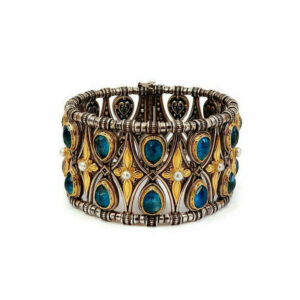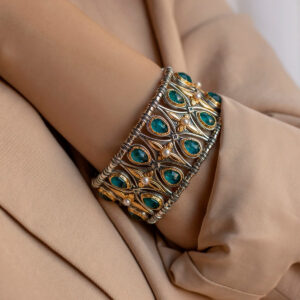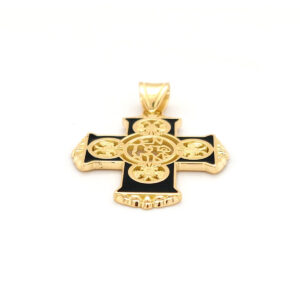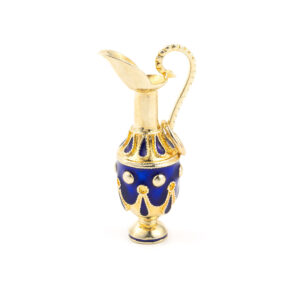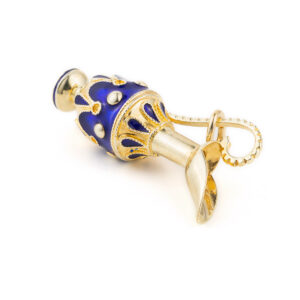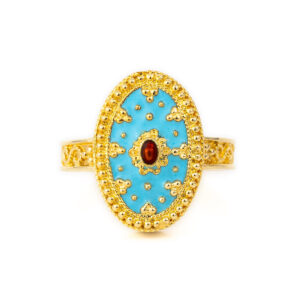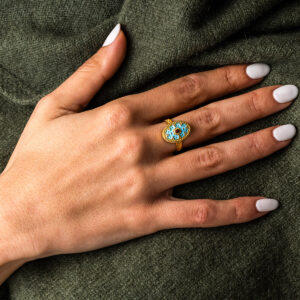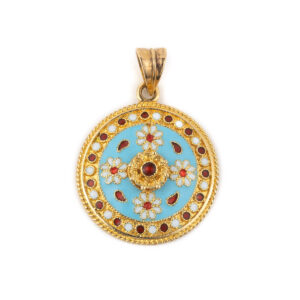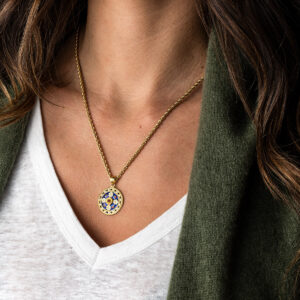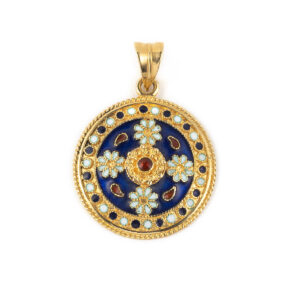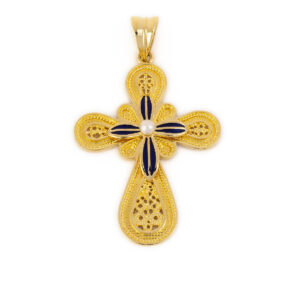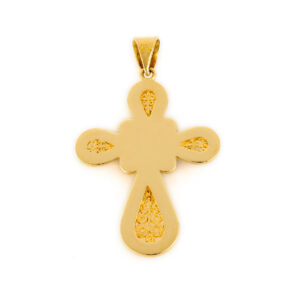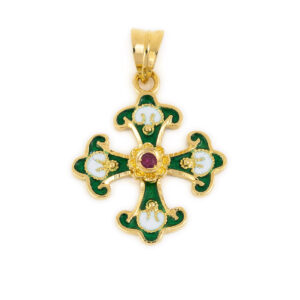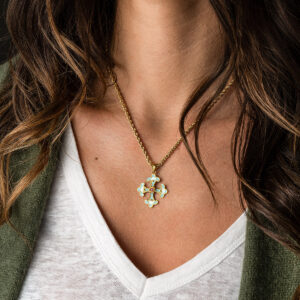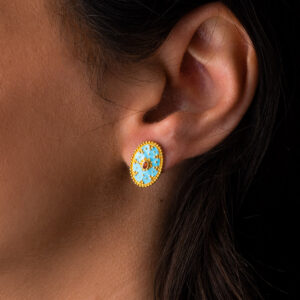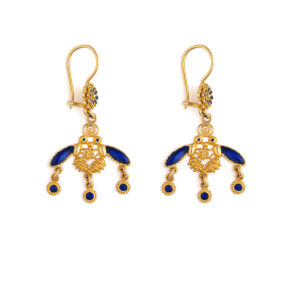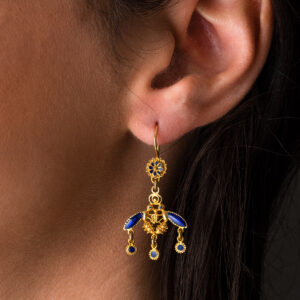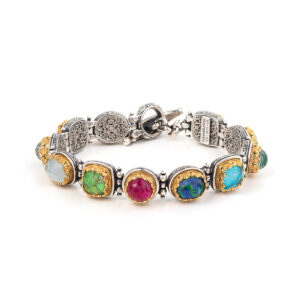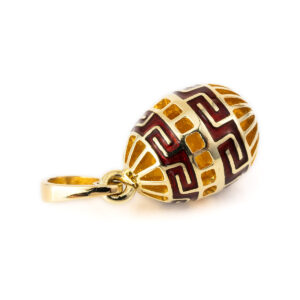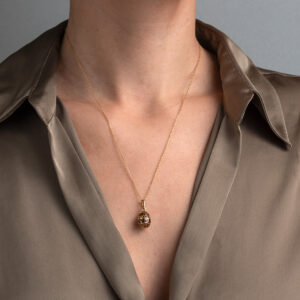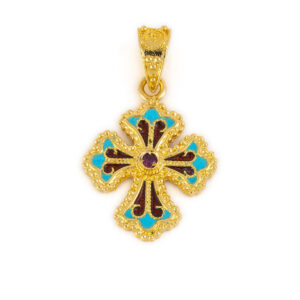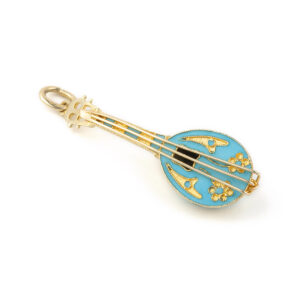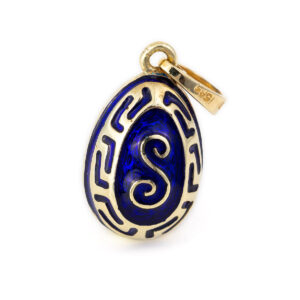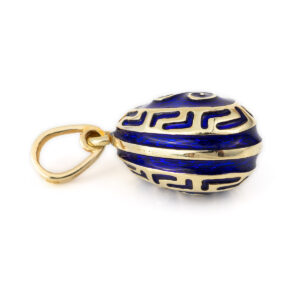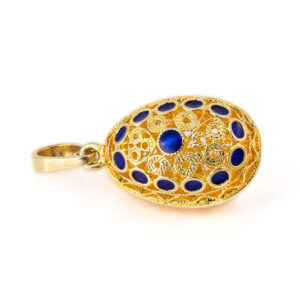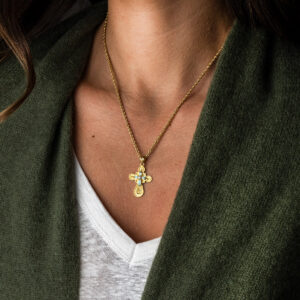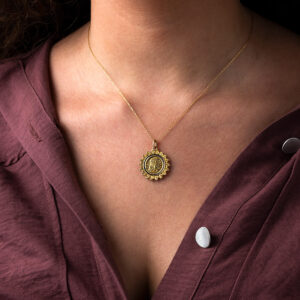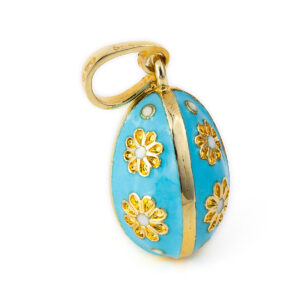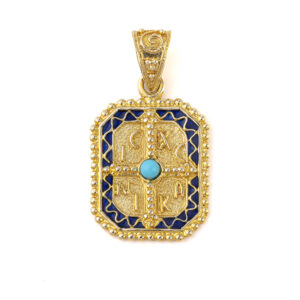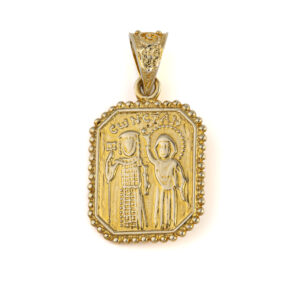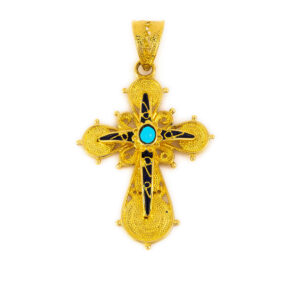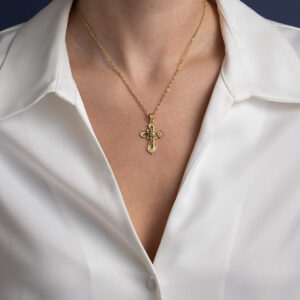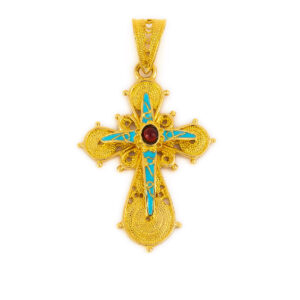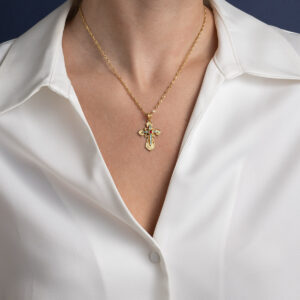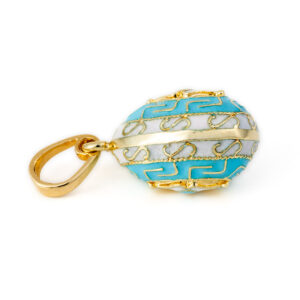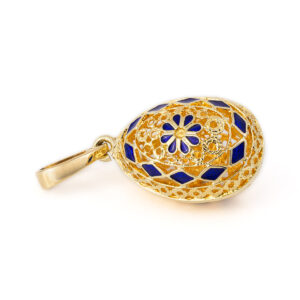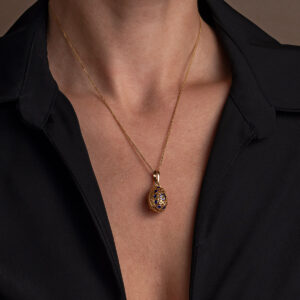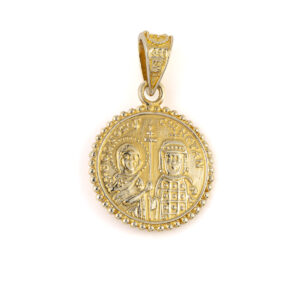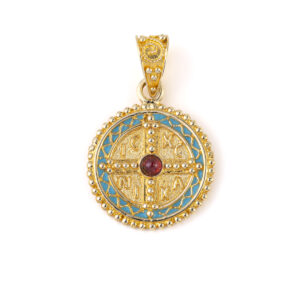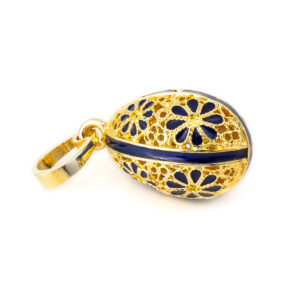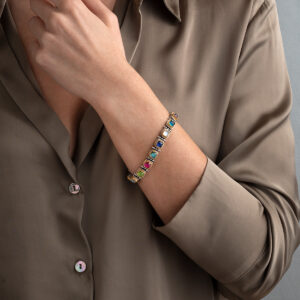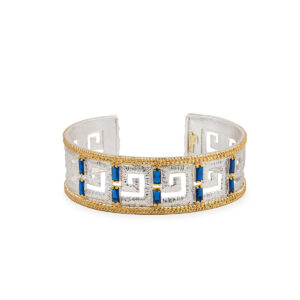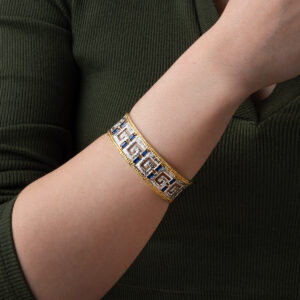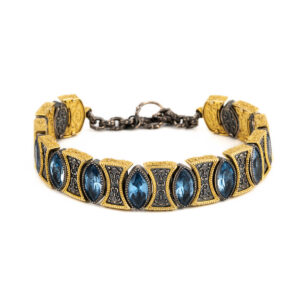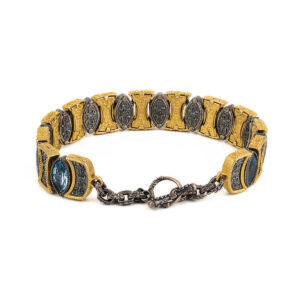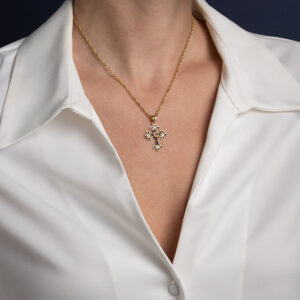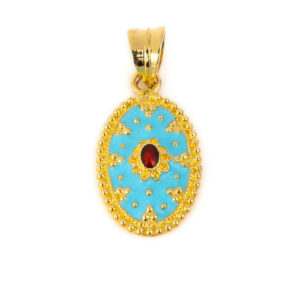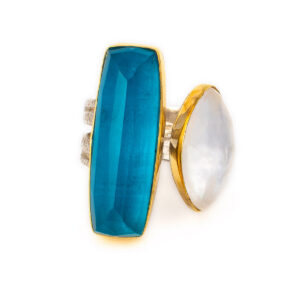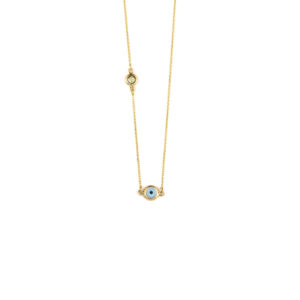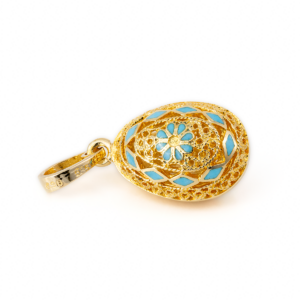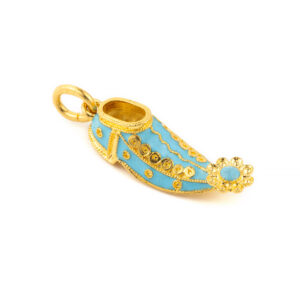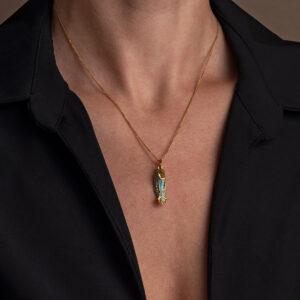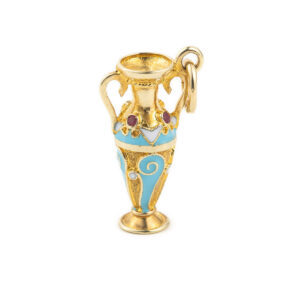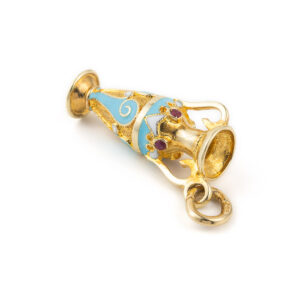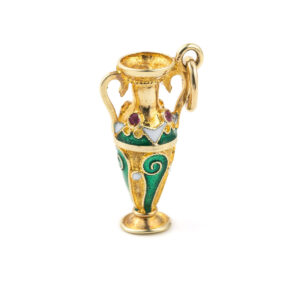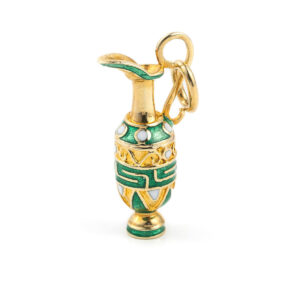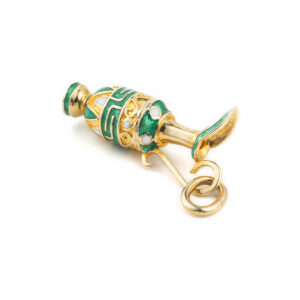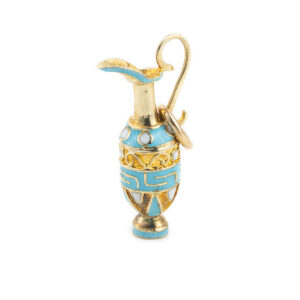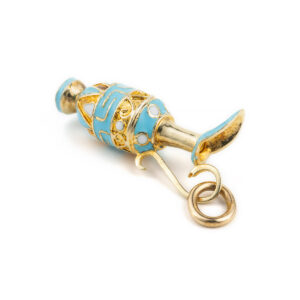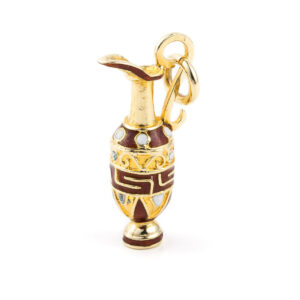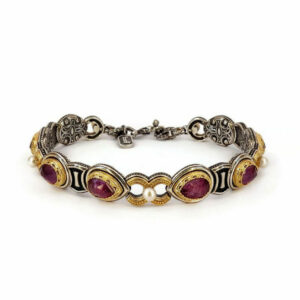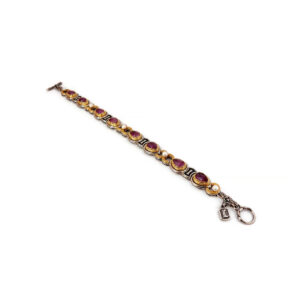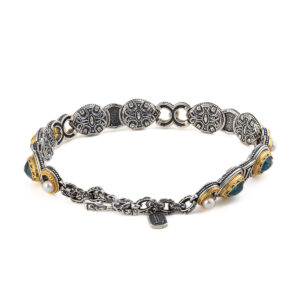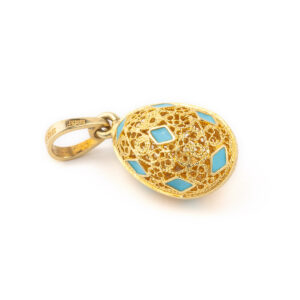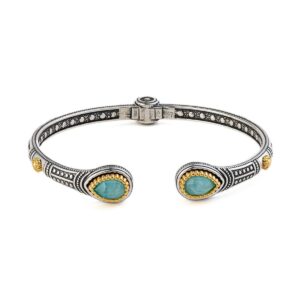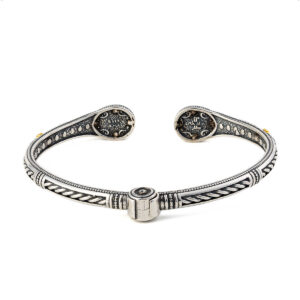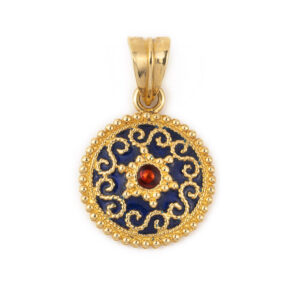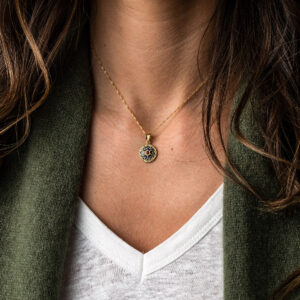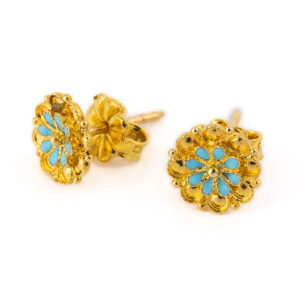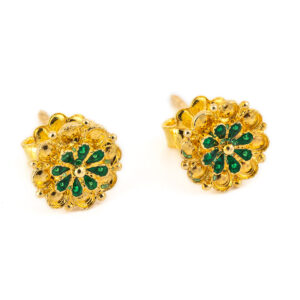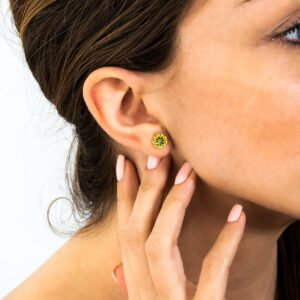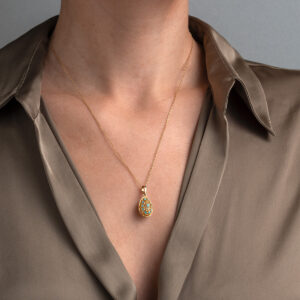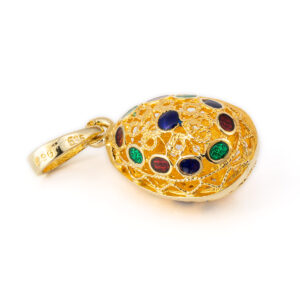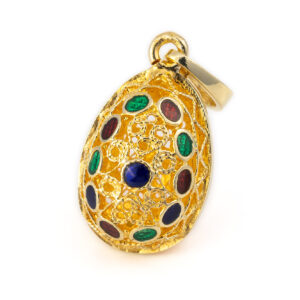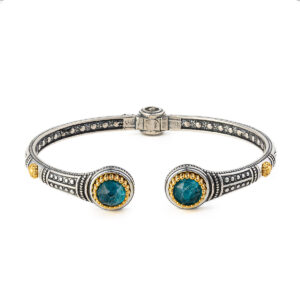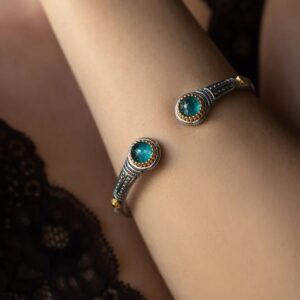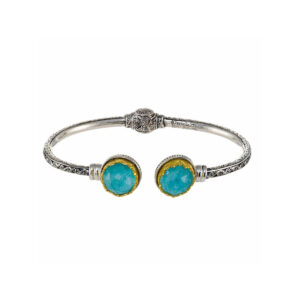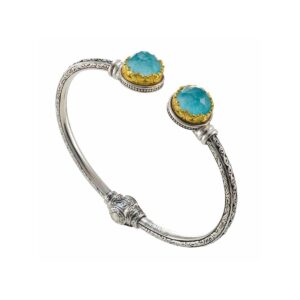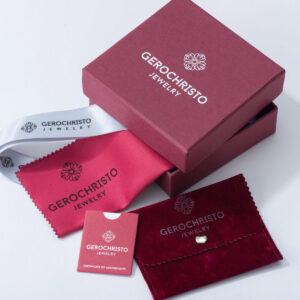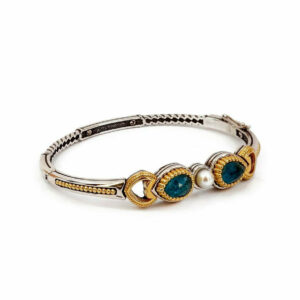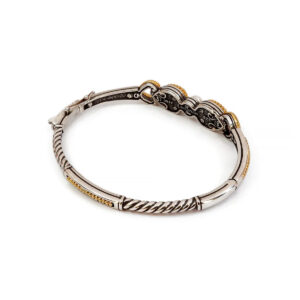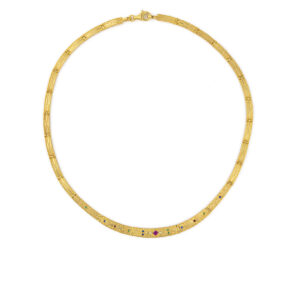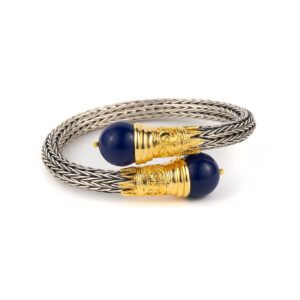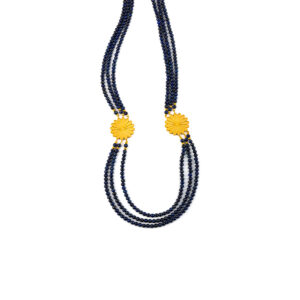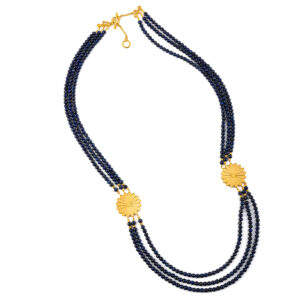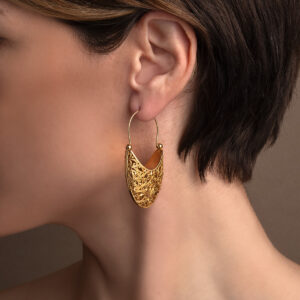Βυζαντινό Βραχιόλι με Μπλε Τοπάζι και Μαργαριτάρι – Ασήμι 925 Επιχρυσωμένο
Βυζαντινό Βραχιόλι με Μπλε Τοπάζι και Μαργαριτάρι.
Κατασκευασμένο από επιχρυσωμένο ασήμι 925⁰.
Χειροποίητο ελληνικό κόσμημα.
Βυζαντινό Βραχιόλι με Απατίτη και Μαργαριτάρι – Ασήμι 925 Επιχρυσωμένο
Βυζαντινό Βραχιόλι με Απατίτη και Μαργαριτάρι.
Κατασκευασμένο από επιχρυσωμένο ασήμι 925⁰.
Χειροποίητο ελληνικό κόσμημα.
Gerochristo – Κολιέ Iris από Ασήμι 925 με Πολλαπλές Πολύτιμες Πέτρες
1.435,00€Κολιέ από ασήμι 925 με επιχρυσωμένα μέρη και πέτρες doublet.
Iris Collection by Gerochristo
Βυζαντινός Σταυρός Εν Τούτω Νίκα – Χρυσό 14Κ
1.386,00€A unique golden cross with turquoise enamel.At the center of the cross there is the inscription “En Touto Nika”, which is literally meaning “in this, conquer”.
Α double headed eagle symbol decorates every edge of the cross.
Handmade with great attention to detail. Inspired by Byzantine Art.
Made of 18k gold. As in all handmade items there may be small differences in weight and dimensions and this is what makes them unique and precious.
Μενταγιόν Αμφορέας – 14Κ Χρυσό
1.309,00€Ancient Greek Amphora Pendant with blue enamel.
Design inspired by the ancient Greek history.
Made in 14k yellow gold
Also available with turquoise or green enamel
Handmade item
Amphora is a Greco – Roman word developed in ancient Greek during the Bronze Age. An amphora is a type of container of a characteristic shape and size. Amphorae were used for the transport and storage of various products, both liquid and dry, but mostly for wine. They are most often ceramic. the amphorae used in Ancient Greek vase painting. (source wikipedia)
18Κ Χρυσό Δαχτυλίδι από Τυρκουάζ Σμάλτο
1.254,00€Χειροποίητο ελληνικό προϊόν με μεγάλη προσοχή στη λεπτομέρεια.
Εμπνευσμένο από τη βυζαντινή τέχνη.
Κατασκευασμένο από χρυσό 18 καρατίων
Η κοκκοποίηση (από τα λατινικά: granum = «κόκκος») είναι μια τεχνική κοσμηματοποιίας με την οποία η επιφάνεια ενός κοσμήματος καλύπτεται με μικρές σφαίρες ή κόκκους πολύτιμου μετάλλου. Η τεχνική θεωρείται ότι έχει τις ρίζες της στη Μεσοποταμία πριν από περίπου 5.000 χρόνια.
18Κ Χρυσό Τυρκουάζ Μενταγιόν με Αρχαια Ελληνική Ροζέτα
1.197,00€Αρχαίο Ελληνικό Στρογγυλό Μενταγιόν με φλοράλ μοτίβο (τέσσερα μοτίβα ροζέτα). Το μενταγιόν είναι διακοσμημένο με τυρκουάζ & κόκκινο σμάλτο και κόκκους πολύτιμου μετάλλου. Η πίσω πλευρά του μενταγιόν δεν έχει διακόσμηση.
Σχεδιασμός εμπνευσμένος από την απίστευτη ομορφιά της ιστορικής παράδοσης.
Από χρυσό 18 καρατίων.
Διατίθεται επίσης με μπλε σμάλτο.
Χειροποίητο ελληνικό κόσμημα.
Η αλυσίδα που απεικονίζεται είναι η 14K χρυσή αλυσίδα rope (δεν περιλαμβάνεται).
Ο ροζέτα (τριαντάφυλλο) είναι ένα διαχρονικό κόσμημα, σύμβολο και φυλαχτό.
Η προέλευση του όρου είναι η ελληνική λέξη για το τριαντάφυλλο – rodon (ρόδον). Η χρήση του ξεκίνησε στη μυκηναϊκή εποχή και συνεχίζεται μέχρι τη 2η χιλιετία π.Χ. Η μυκηναϊκή ρόδα είναι ένα μοτίβο που ήταν ευρέως διαδεδομένο σε όλη τη Μεσοποταμία, την Αίγυπτο, την Ελλάδα και άλλους αρχαίους πολιτισμούς. Είναι εμπνευσμένο από μια χάντρα με μυκηναϊκή ροζέτα, που βρέθηκε στις Μυκήνες και χρονολογείται στο 1400-1300 π.Χ. Η ροζέτα χρησιμοποιήθηκε εκτενώς στα αρχαία ελληνικά μυκηναϊκά κοσμήματα, στην αρχιτεκτονική, στην κεραμική και στα γλυπτά από το 1500 π.Χ. Οι μυκηναϊκοί ρόδακες είχαν συνήθως 6 ή 8 ή 12 φύλλα και δεκαέξι φύλλα κατά τη διάρκεια της Μακεδονικής Δυναστείας. Τέτοιες λεπτομέρειες όπως το σχήμα του ρόδακα και ο αριθμός των φύλλων τείνουν να ποικίλλουν ανάλογα με την εποχή ή τις δοξασίες. Οι ρόδακες χρησιμοποιούνταν για τη διακόσμηση των υφασμάτων, των ζωνών και των στεφάνων των βασιλέων. Ο αριθμός των φύλλων είχε συμβολικό χαρακτήρα κάθε φορά. Τα τέσσερα στοιχεία της φύσης (άνεμος, γη, φωτιά, νερό), τα επτά θαύματα του αρχαίου κόσμου ή οι δώδεκα θεοί των αρχαίων Ελλήνων και η παγκόσμια κυριαρχία και ακτινοβολία των βασιλιάδων της Μακεδονίας. Ήταν σημάδια ομορφιάς, αγνότητας, ευζωίας, λατρείας και εξουσίας. Η ροζέτα ή ρόδαξ ήταν ίσως το πιο δημοφιλές και αγαπημένο διακοσμητικό στοιχείο στη μυκηναϊκή εποχή, την κλασική αρχαιότητα και τους βυζαντινούς χρόνους.
18Κ Χρυσό Μπλε Μενταγιόν με Αρχαια Ελληνική Ροζέτα
1.197,00€Αρχαίο Ελληνικό Στρογγυλό Μενταγιόν με φλοράλ μοτίβο (τέσσερα μοτίβα ροζέτα). Το μενταγιόν είναι διακοσμημένο με τυρκουάζ & κόκκινο σμάλτο και κόκκους πολύτιμου μετάλλου. Η πίσω πλευρά του μενταγιόν δεν έχει διακόσμηση.
Σχεδιασμός εμπνευσμένος από την απίστευτη ομορφιά της ιστορικής παράδοσης.
Από χρυσό 18 καρατίων.
Διατίθεται επίσης με τυρκουάζ σμάλτο.
Χειροποίητο ελληνικό κόσμημα.
Η αλυσίδα που απεικονίζεται είναι η 14K χρυσή αλυσίδα rope (δεν περιλαμβάνεται).
Ο ροζέτα (τριαντάφυλλο) είναι ένα διαχρονικό κόσμημα, σύμβολο και φυλαχτό.
Η προέλευση του όρου είναι η ελληνική λέξη για το τριαντάφυλλο – rodon (ρόδον). Η χρήση του ξεκίνησε στη μυκηναϊκή εποχή και συνεχίζεται μέχρι τη 2η χιλιετία π.Χ. Η μυκηναϊκή ρόδα είναι ένα μοτίβο που ήταν ευρέως διαδεδομένο σε όλη τη Μεσοποταμία, την Αίγυπτο, την Ελλάδα και άλλους αρχαίους πολιτισμούς. Είναι εμπνευσμένο από μια χάντρα με μυκηναϊκή ροζέτα, που βρέθηκε στις Μυκήνες και χρονολογείται στο 1400-1300 π.Χ. Η ροζέτα χρησιμοποιήθηκε εκτενώς στα αρχαία ελληνικά μυκηναϊκά κοσμήματα, στην αρχιτεκτονική, στην κεραμική και στα γλυπτά από το 1500 π.Χ. Οι μυκηναϊκοί ρόδακες είχαν συνήθως 6 ή 8 ή 12 φύλλα και δεκαέξι φύλλα κατά τη διάρκεια της Μακεδονικής Δυναστείας. Τέτοιες λεπτομέρειες όπως το σχήμα του ρόδακα και ο αριθμός των φύλλων τείνουν να ποικίλλουν ανάλογα με την εποχή ή τις δοξασίες. Οι ρόδακες χρησιμοποιούνταν για τη διακόσμηση των υφασμάτων, των ζωνών και των στεφάνων των βασιλέων. Ο αριθμός των φύλλων είχε συμβολικό χαρακτήρα κάθε φορά. Τα τέσσερα στοιχεία της φύσης (άνεμος, γη, φωτιά, νερό), τα επτά θαύματα του αρχαίου κόσμου ή οι δώδεκα θεοί των αρχαίων Ελλήνων και η παγκόσμια κυριαρχία και ακτινοβολία των βασιλιάδων της Μακεδονίας. Ήταν σημάδια ομορφιάς, αγνότητας, ευζωίας, λατρείας και εξουσίας. Η ροζέτα ή ρόδαξ ήταν ίσως το πιο δημοφιλές και αγαπημένο διακοσμητικό στοιχείο στη μυκηναϊκή εποχή, την κλασική αρχαιότητα και τους βυζαντινούς χρόνους.
18K Gold Flower Cross with Filigree and Pearl
1.144,00€The cross is embellished with a fine filigree, blue enamel and a pearl in the middle of the flower
Inspired by Byzantine art.
Made in 18k gold
Handmade item.
Filigree is a delicate kind of jewellery metalwork, made with tiny beads or twisted threads, or both in combination, soldered together or to the surface of an object of the same metal and arranged in artistic motifs. The art of filigree dates back to ancient history. The first of the found jewelry in this technique have been found in Mesopotamia and dates to thousands of years BC. In the ancient world and particularly in Asia Minor, this art grew were at the highest level.
Βυζαντινός Σταυρός με Ρουμπίνι – 18Κ Χρυσό
490,00€ – 1.070,00€Βυζαντινός Σταυρός στολισμένος με σμάλτο, λουλούδι ροζέτα στο κέντρο που είναι διακοσμημένο με ρουμπίνι και κόκκους πολύτιμου μετάλλου. Η πίσω πλευρά του σταυρού δεν έχει διακόσμηση.
Χειροποίητο με μεγάλη προσοχή στη λεπτομέρεια. Εμπνευσμένο από τη βυζαντινή τέχνη. Κατασκευασμένο από χρυσό 18 καρατίων.
Διατίθεται σε 4 χρώματα σμάλτου: Τυρκουάζ, Μπλε, Πράσινο, Κόκκινο Διατίθεται σε 3 μεγέθη: Small, Medium, Large
Η αλυσίδα που εμφανίζεται είναι η αλυσίδα χρυσού 14 καρατίων (δεν περιλαμβάνεται).
Το φιλιγκράν είναι ένα λεπτό είδος μεταλλικού κοσμήματος, κατασκευασμένο με μικροσκοπικές χάντρες ή στριμμένα νήματα, ή και τα δύο σε συνδυασμό, συγκολλημένα μεταξύ τους ή στην επιφάνεια ενός αντικειμένου από το ίδιο μέταλλο και διατεταγμένα σε καλλιτεχνικά μοτίβα. Η τέχνη του φιλιγκράν χρονολογείται από την αρχαία ιστορία. Το πρώτο από τα κοσμήματα που βρέθηκαν σε αυτή την τεχνική έχει βρεθεί στη Μεσοποταμία και χρονολογείται χιλιάδες χρόνια π.Χ. Στον αρχαίο κόσμο και ιδιαίτερα στη Μικρά Ασία, η τέχνη αυτή αναπτύχθηκε στο υψηλότερο επίπεδο. Η κοκκοποίηση (από τα λατινικά: granum = «κόκκος») είναι μια τεχνική κοσμήματος κατά την οποία μια επιφάνεια ενός κοσμήματος καλύπτεται με μικρές σφαίρες ή κόκκους πολύτιμου μετάλλου. Η τεχνική θεωρείται ότι έχει τις ρίζες της στη Μεσοποταμία πριν από περίπου 5.000 χρόνια. Λουλούδι ροζέτας Η ροζέτα (τριαντάφυλλο) είναι ένα διαχρονικό κόσμημα, σύμβολο και φυλαχτό. Η προέλευση του όρου είναι η ελληνική λέξη για το τριαντάφυλλο – ροδόν. Η χρήση του ξεκίνησε από τη μυκηναϊκή εποχή και συνεχίζεται μέχρι τη 2η χιλιετίες π.Χ. Η Μυκηναϊκή Ροζέτα είναι ένα μοτίβο που ήταν διαδεδομένο σε όλη τη Μεσοποταμία, την Αίγυπτο, την Ελλάδα και άλλους αρχαίους πολιτισμούς. Είναι εμπνευσμένο από μια μυκηναϊκή χάντρα ρόδακα, που βρέθηκε στις Μυκήνες, που χρονολογείται μεταξύ 1400-1300 π.Χ. Ο ρόδακας χρησιμοποιήθηκε εκτενώς στα αρχαία ελληνικά μυκηναϊκά κοσμήματα, στην αρχιτεκτονική, την κεραμική και στα γλυπτά από το 1500 π.Χ. Οι μυκηναϊκοί ρόδακες είχαν συνήθως 6 ή 8 ή 12 φύλλα και δεκαέξι φύλλα κατά τη Μακεδονική Δυναστεία. Λεπτομέρειες όπως το σχήμα rodax και ο αριθμός των φύλλων τείνουν να ποικίλλουν ανάλογα με την εποχή ή τις πεποιθήσεις. Οι ροζέτες χρησιμοποιήθηκαν για να διακοσμήσουν τα ρούχα, τις ζώνες και τα στεφάνια των Βασιλέων. Ο αριθμός των φύλλων είχε συμβολικό χαρακτήρα κάθε φορά. Τα τέσσερα στοιχεία της φύσης (άνεμος, γη, φωτιά, νερό), τα επτά θαύματα του αρχαίου κόσμου ή οι δώδεκα θεοί των αρχαίων Ελλήνων και η παγκόσμια κυριαρχία και ακτινοβολία των Βασιλέων της Μακεδονίας. Ήταν σημάδια ομορφιάς, αγνότητας, ευγονικής, λατρείας και δύναμης. Η ροζέτα ή Ροδάξ ήταν ίσως το πιο δημοφιλές και αγαπημένο διακοσμητικό στοιχείο στη μυκηναϊκή εποχή, την κλασική αρχαιότητα και τους βυζαντινούς χρόνους.
18Κ Χρυσά Σκουλαρίκια με Τυρκουάζ Σμάλτο
968,00€Βυζαντινά σκουλαρίκια διακοσμημένα με λεπτό φιλιγκράν και κόκκους από πολύτιμο μέταλλο.
Χειροποίητο ελληνικό κόσμημα με μεγάλη προσοχή στη λεπτομέρεια. Εμπνευσμένο από τη βυζαντινή τέχνη.
Από χρυσό 18 καρατίων.
Η κοκκοποίηση (από τα λατινικά: granum = «κόκκος») είναι μια τεχνική κοσμηματοποιίας με την οποία η επιφάνεια ενός κοσμήματος καλύπτεται με μικρές σφαίρες ή κόκκους πολύτιμου μετάλλου. Η τεχνική θεωρείται ότι έχει τις ρίζες της στη Μεσοποταμία πριν από περίπου 5.000 χρόνια.
Μενταγιόν Αυγό Φιλιγκράν με Λουλούδια – Χρυσός 14Κ και Τυρκουάζ Σμάλτο
612,00€ – 952,00€Το μενταγιόν είναι διακοσμημένο με λουλούδια σε στυλ Faberge.
Χρησιμοποιείται ως γούρι ή ως μενταγιόν.
Διαλέξτε ένα όμορφο δώρο εμπνευσμένο από τη μεγαλοπρεπή τέχνη της Fabergé!
Κατασκευασμένο από χρυσό 14 καρατίων και τυρκουάζ σμάλτο.
Η αλυσίδα που απεικονίζεται είναι η 14Κ Gourmet Χρυσή Αλυσίδα μας (δεν περιλαμβάνεται).
Η ροζέτα (τριαντάφυλλο) είναι ένα διαχρονικό κόσμημα, σύμβολο και φυλαχτό. Η προέλευση του όρου είναι η ελληνική λέξη για το τριαντάφυλλο – rodon (ρόδον). Η χρήση του ξεκίνησε στη μυκηναϊκή εποχή και συνεχίζεται μέχρι τη 2η χιλιετία π.Χ. Η μυκηναϊκή ρόδα είναι ένα μοτίβο που ήταν ευρέως διαδεδομένο σε όλη τη Μεσοποταμία, την Αίγυπτο, την Ελλάδα και άλλους αρχαίους πολιτισμούς. Η ροζέτα ή Ροδάξ ήταν ίσως το πιο δημοφιλές και αγαπημένο διακοσμητικό στοιχείο στη μυκηναϊκή εποχή, την κλασική αρχαιότητα και τους βυζαντινούς χρόνους.
Το αυγό Φαμπερζέ είναι ένα αυγό κοσμήμα που δημιουργήθηκε από τον οίκο Φαμπερζέ, στην Αγία Πετρούπολη της αυτοκρατορικής Ρωσίας. Σχεδόν όλα κατασκευάστηκαν υπό την επίβλεψη του Πέτερ Καρλ Φαμπερζέ μεταξύ 1885 και 1917,[παραπομπή απαιτείται] με πιο διάσημα τα 50 «αυτοκρατορικά» αυγά, 43 από τα οποία σώζονται, που κατασκευάστηκαν για τους Ρώσους τσάρους Αλέξανδρο Γ’ και Νικόλαο Β’ ως πασχαλινά δώρα για τις συζύγους και τις μητέρες τους. Το πρώτο αυγό Φαμπερζέ φιλοτεχνήθηκε για τον τσάρο Αλέξανδρο Γ΄, ο οποίος είχε αποφασίσει να χαρίσει στη σύζυγό του, την αυτοκράτειρα Μαρία Φεοντόροβνα, ένα πασχαλινό αυγό το 1885. Ο Peter Carl Fabergé ήταν ένας Ρώσος κοσμηματοπώλης, γνωστός κυρίως για τα περίφημα αυγά Fabergé που κατασκευάστηκαν στο στυλ των γνήσιων πασχαλινών αυγών, χρησιμοποιώντας πολύτιμα μέταλλα και πολύτιμους λίθους. Είναι ο ιδρυτής της διάσημης κληρονομιάς κοσμημάτων του οίκου Fabergé.
Όπως σε όλα τα χειροποίητα κοσμήματα μπορεί να υπάρχουν μικρές διαφορές στο βάρος και τις διαστάσεις και αυτό είναι που τα κάνει μοναδικά και πολύτιμα.
Minoan Malia Bees Dangle Earrings – 18K Solid Yellow Gold and enamel
945,00€Dangle earrings inspired by the ancient Minoan Greek Malia bees pendant.
Made of 18K Gold.
Handmade item.
The Minoan Bees Pendant, one of the most famous Minoan artworks, was discovered in the Old Palace cemetery at Chrysolakkos, outside the palace of Malia, the third largest and most significant known Minoan palace after Knossos and Phaistos. Chryssolakkos means the “Pit of gold” because of the many precious objects that were found there. The famous pendant dates back to the Bronze Age, (1800 BC) and it’s an stunning, very detailed representation of two bees or wasps storing away a drop of honey to their honeycomb. This pendant is one of the most famous exhibits in the wonderfully Heraklion archeological museum.
As in all handmade items there may be small differences in weight and dimensions and this is what makes them unique and precious.
Gerochristo – Iris bracelet with Multi Precious Stones
823,00€Necklace in sterling silver with gold plated parts and doublet stones.
Iris Collection by Gerochristo
Μενταγιόν Αυγό Μαίανδρος – Χρυσό 14Κ και Κόκκινο Σμάλτο
765,00€Το μενταγιόν είναι διακοσμημένο με το σχέδιο του μαίανδρου.
Χρησιμοποιείται ως γούρι ή ως μενταγιόν.
Πάρτε ένα όμορφο δώρο εμπνευσμένο από τη μεγαλοπρεπή τέχνη της Fabergé!
Κατασκευασμένο από χρυσό 14 καρατίων και κόκκινο σμάλτο.
Διατίθεται με μπλε ή πράσινο ή τυρκουάζ σμάλτο
Το σχέδιο Μαίανδρου είναι ένα διακοσμητικό περίγραμμα που κατασκευάζεται από μια συνεχή γραμμή, η οποία διαμορφώνεται σε ένα επαναλαμβανόμενο μοτίβο. Ένα τέτοιο σχέδιο αποκαλείται επίσης σχέδιο ελληνικού κροσσού ή ελληνικού κλειδιού, αν και πρόκειται για σύγχρονες ονομασίες. Από τη μία πλευρά, το όνομα «μαιάνδρος» θυμίζει τη στριμμένη και στρεφόμενη διαδρομή του ποταμού Μαιάνδρου στη Μικρά Ασία, και από την άλλη πλευρά, όπως τόνισε ο Karl Kerenyi, «ο μαιάνδρος είναι το σχήμα ενός λαβύρινθου σε γραμμική μορφή» το νόημα είναι ότι αυτά δεν υπάρχει αρχή και να τελειώσει τέλος σε ορισμένες περιπτώσεις, έτσι ώστε να γίνει το σύμβολο της μακράς ζωής και της αιωνιότητας.
Το αυγό Fabergé είναι ένα αυγό κόσμημα που δημιουργήθηκε από τον οίκο Fabergé, στην Αγία Πετρούπολη της αυτοκρατορικής Ρωσίας. Σχεδόν όλα κατασκευάστηκαν υπό την επίβλεψη του Πέτερ Καρλ Φαμπερζέ μεταξύ 1885 και 1917,[παραπομπή απαιτείται] με πιο διάσημα τα 50 «αυτοκρατορικά» αυγά, 43 από τα οποία σώζονται, που κατασκευάστηκαν για τους Ρώσους τσάρους Αλέξανδρο Γ’ και Νικόλαο Β’ ως πασχαλινά δώρα για τις συζύγους και τις μητέρες τους. Το πρώτο αυγό Φαμπερζέ φιλοτεχνήθηκε για τον τσάρο Αλέξανδρο Γ΄, ο οποίος είχε αποφασίσει να χαρίσει στη σύζυγό του, την αυτοκράτειρα Μαρία Φεοντόροβνα, ένα πασχαλινό αυγό το 1885. Ο Peter Carl Fabergé ήταν ένας Ρώσος κοσμηματοπώλης, γνωστός κυρίως για τα περίφημα αυγά Fabergé που κατασκευάστηκαν στο στυλ των γνήσιων πασχαλινών αυγών, χρησιμοποιώντας πολύτιμα μέταλλα και πολύτιμους λίθους. Είναι ο ιδρυτής της διάσημης κληρονομιάς κοσμημάτων του οίκου Fabergé.
Όπως σε όλα τα χειροποίητα κοσμήματα, ενδέχεται να υπάρχουν μικρές διαφορές στο βάρος και τις διαστάσεις, γεγονός που τα καθιστά μοναδικά και πολύτιμα.
18K Gold Byzantine Filigree Cross with Turquoise Enamel
738,00€Byzantine Cross is embellished with a fine filigree, turquoise & red enamel and granules of precious metal.
The back side of the cross has not decoration.
Handmade with the great attention to detail. Inspired by Byzantine art.
Made in 18k gold
Filigree is a delicate kind of jewellery metalwork, made with tiny beads or twisted threads, or both in combination, soldered together or to the surface of an object of the same metal and arranged in artistic motifs. The art of filigree dates back to ancient history. The first of the found jewelry in this technique have been found in Mesopotamia and dates to thousands of years BC. In the ancient world and particularly in Asia Minor, this art grew were at the highest level.
Granulation (from Latin: granum = “grain”) is a jewellery technique whereby a surface of a jewel is covered with small spheres or granules of precious metal. The technique is thought to have its origins in Mesopotamia about 5,000 years ago.
As in all handmade items there may be small differences in weight and dimensions and this is what makes them unique and precious.
Μενταγιόν Μπουζούκι – 14Κ Χρυσό
730,00€Greek Bouzouki Charm with turquoise enamel. The pendant is decorated with rosette motifs.
Made in 14k yellow gold.
Used as a charm or as a pendant.
Design inspired by the Greek tradition
The Greek bouzouki is a plucked musical instrument of the lute family, called the thabouras or tambouras family. The tambouras has existed in ancient Greece as pandoura, and can be found in various sizes and shapes. The bouzouki and the baglamas are the direct descendants. The bouzouki arrived in Greece following the 1919–1922 war in Asia Minor and the subsequent exchange of populations between Greece and Turkey when the ethnic Greeks fled to Greece. At the end of the 1950s, four-course (tetrachordo) bouzoukia started to gain popularity. The four-course bouzouki was made popular by Manolis Chiotis. Manolis Chiotis was a Greek rebetiko and laiko composer, singer, and bouzouki player. He is considered one of the greatest bouzouki soloists of all time. In the summer of 1961, he played for Aristotle Onassis and Maria Callas and Grace Kelly. Callas told Chiotis that she had been translating the lyrics of his songs to Princess Grace all night long and the American actress loved them because “she is a woman in love.” At that moment, Kelly asked Chiotis what the difference between a bouzouki and an electric guitar is. Chiotis’ answer was rather unexpected; “Mrs. Callas, please explain to Princess Grace that the strings of an electric guitar vibrate due to electricity, while the strings of a bouzouki vibrate through the heart.” *
The rosette (rose) is a timeless jewel, symbol and amulet. The origin of the term is the Greek word for rose – rodon (ρόδον). Its use began in the Mycenaean era and continues as far as the 2nd millennia BC. The Mycenaean Rosette is a motif that was widespread throughout Mesopotamia, Egypt, Greece and other ancient civilizations. Rosette or Rodax was probably the most popular and favorite decorative element in Mycenaean era, classical antiquity and Byzantine times.
Μενταγιόν Αυγό με Μαιάνδρο – Χρυσός 14Κ και Μπλε Σμάλτο
730,00€Το μενταγιόν είναι διακοσμημένο με σχέδιο μαίανδρου.
Χρησιμοποιείται ως γούρι ή ως μενταγιόν.
Πάρτε ένα όμορφο δώρο εμπνευσμένο από τη μεγαλοπρεπή τέχνη της Fabergé!
Κατασκευασμένο από χρυσό 14 καρατίων και μπλε σμάλτο.
Διατίθεται με μπλε ή πράσινο ή κόκκινο σμάλτο.
Το αυγό Fabergé είναι ένα αυγό με κοσμήματα που δημιουργήθηκε από τον οίκο Fabergé, στην Αγία Πετρούπολη της αυτοκρατορικής Ρωσίας. Σχεδόν όλα κατασκευάστηκαν υπό την επίβλεψη του Πέτερ Καρλ Φαμπερζέ μεταξύ 1885 και 1917, με πιο διάσημα τα 50 «αυτοκρατορικά» αυγά, 43 από τα οποία σώζονται, που κατασκευάστηκαν για τους Ρώσους τσάρους Αλέξανδρο Γ’ και Νικόλαο Β’ ως πασχαλινά δώρα για τις συζύγους και τις μητέρες τους. Το πρώτο αυγό Φαμπερζέ φιλοτεχνήθηκε για τον τσάρο Αλέξανδρο Γ΄, ο οποίος είχε αποφασίσει να χαρίσει στη σύζυγό του, την αυτοκράτειρα Μαρία Φεοντόροβνα, ένα πασχαλινό αυγό το 1885. Ο Peter Carl Fabergé ήταν ένας Ρώσος κοσμηματοπώλης, γνωστός κυρίως για τα περίφημα αυγά Fabergé που κατασκευάστηκαν στο στυλ των γνήσιων πασχαλινών αυγών, χρησιμοποιώντας πολύτιμα μέταλλα και πολύτιμους λίθους. Είναι ο ιδρυτής της διάσημης κληρονομιάς κοσμημάτων του οίκου Fabergé.
Σχέδιο μαίανδρου, ένα από τα πιο ιστορικά σύμβολα του ελληνικού κόσμου, που ονομάζεται επίσης ελληνικό κλειδί και συμβολίζει τη μακροζωία και την αιωνιότητα. Το μοτίβο με τον Μαίανδρο χρησιμοποιούνταν στην αρχαιότητα για τη διακόσμηση της ζωφόρου των ναών.
Όπως σε όλα τα χειροποίητα αντικείμενα μπορεί να υπάρχουν μικρές διαφορές στο βάρος και τις διαστάσεις και αυτό είναι που τα κάνει μοναδικά και πολύτιμα.
Filigree Egg Pendant – 14k Gold with Blue Enamel
730,00€The pendant is embellished with a fine filigree and blue enamel in Faberge style.
Used as a charm or as a pendant.
Pick up a beautiful gift inspired by the majestic art of Fabergé!
Made in 14k yellow gold
Available with green or red or multi color or turquoise enamel
Filigree is a delicate kind of jewellery metalwork, made with tiny beads or twisted threads, or both in combination, soldered together or to the surface of an object of the same metal and arranged in artistic motifs. The art of filigree dates back to ancient history. The first of the found jewelry in this technique have been found in Mesopotamia and dates to thousands of years BC. In the ancient world and particularly in Asia Minor, this art grew were at the highest level.
Fabergé egg is a jeweled egg created by the House of Fabergé, in St. Petersburg, Imperial Russia. Virtually all were manufactured under the supervision of Peter Carl Fabergé between 1885 and 1917,[citation needed] the most famous being the 50 “Imperial” eggs, 43 of which survive, made for the Russian Tsars Alexander III and Nicholas II as Easter gifts for their wives and mothers. The first Fabergé egg was crafted for Tsar Alexander III, who had decided to give his wife, the Empress Maria Feodorovna, an Easter egg in 1885. Peter Carl Fabergé was a Russian jeweller best known for the famous Fabergé eggs made in the style of genuine Easter eggs, using precious metals and gemstones. He’s the founder of the famous jewelry legacy House of Fabergé.
As in all handmade items there may be small differences in weight and dimensions and this is what makes them unique and precious.
18K Gold Filigree Cross with Pearl
726,00€The cross is embellished with a fine filigree, turquoise enamel and pearl.
Inspired by Byzantine art.
Made in 18k gold
Handmade item.
The chain shown is not included.
Filigree is a delicate kind of jewellery metalwork, made with tiny beads or twisted threads, or both in combination, soldered together or to the surface of an object of the same metal and arranged in artistic motifs. The art of filigree dates back to ancient history. The first of the found jewelry in this technique have been found in Mesopotamia and dates to thousands of years BC. In the ancient world and particularly in Asia Minor, this art grew were at the highest level.
14K Χρυσό Μενταγιόν Νόμισμα Θεά Αθηνά
715,00€Η μπροστινή πλευρά αυτού του μενταγιόν είναι διακοσμημένη με τη θεά Αθηνά και η πίσω πλευρά είναι διακοσμημένη με την κουκουβάγια της σοφίας.
Κατασκευασμένο από χρυσό 14 καρατίων και μπλε σμάλτο.
Η αλυσίδα που απεικονίζεται είναι η 14Κ Χρυσή Αλυσίδα Cable (δεν περιλαμβάνονται).
Θεά Αθηνά και Κουκουβάγια – Αθηναϊκό αργυρό τετράδραχμο
Αυτό το νόμισμα ανήκει στα λεγόμενα «αθηναϊκά νομίσματα νέου στυλ» που κόπηκαν μεταξύ 166 και 64 π.Χ. και θεωρείται ένα από τα πιο δημοφιλή αρχαία ελληνικά νομίσματα που απεικονίζουν το πορτρέτο της Θεάς Αθηνάς. Η Αθηνά σχετίζεται με τη σοφία, τη χειροτεχνία και τον πόλεμο. Η Αθηνά θεωρούνταν προστάτιδα διαφόρων πόλεων σε όλη την Ελλάδα, αλλά ιδιαίτερα της Αθήνας, η οποία πήρε το όνομά της από εκείνη. Συνήθως εμφανίζεται στην τέχνη φορώντας κράνος και κρατώντας ένα δόρυ. Τα κύρια σύμβολά της περιλαμβάνουν κουκουβάγιες, ελιές και φίδια. Οι ναοί της βρίσκονταν στην οχυρωμένη Ακρόπολη στο κεντρικό τμήμα της πόλης. Ο Παρθενώνας στην Ακρόπολη της Αθήνας είναι αφιερωμένος σε αυτήν, μαζί με πολλούς άλλους ναούς και μνημεία. Το κύριο πανηγύρι της στην Αθήνα ήταν τα Παναθήναια, τα οποία γιορτάζονταν το καλοκαίρι και ήταν το σημαντικότερο πανηγύρι του αθηναϊκού ημερολογίου. Στο κλασικό Ολύμπιο πάνθεον, η Αθηνά θεωρούνταν η αγαπημένη κόρη του Δία. Η κουκουβάγια συνοδεύει παραδοσιακά την Αθηνά. Λόγω αυτής της συσχέτισης, η κουκουβάγια έχει χρησιμοποιηθεί ως σύμβολο γνώσης και σοφίας. Οι επιγραφές περιέχουν την «εθνική» ονομασία της πόλης («ΑΘΕ», δηλαδή «των Αθηναίων»).
Μενταγιόν Αυγό με Ροζέτα – Χρυσός 14Κ
680,00€Το μενταγιόν είναι διακοσμημένο με ροζέτες λουλουδιών σε στυλ Faberge.
Χρησιμοποιείται ως γούρι ή ως κρεμαστό κόσμημα.
Διαλέξτε ένα όμορφο δώρο εμπνευσμένο από τη μεγαλοπρεπή τέχνη της Fabergé!
Κατασκευασμένο από χρυσό 14 καρατίων και τυρκουάζ σμάλτο.
Το αυγό Fabergé είναι ένα αυγό κόσμημα που δημιουργήθηκε από τον οίκο Fabergé, στην Αγία Πετρούπολη της αυτοκρατορικής Ρωσίας. Σχεδόν όλα κατασκευάστηκαν υπό την επίβλεψη του Πέτερ Καρλ Φαμπερζέ μεταξύ 1885 και 1917,[παραπομπή απαιτείται] με πιο διάσημα τα 50 «αυτοκρατορικά» αυγά, 43 από τα οποία σώζονται, που κατασκευάστηκαν για τους Ρώσους τσάρους Αλέξανδρο Γ’ και Νικόλαο Β’ ως πασχαλινά δώρα για τις συζύγους και τις μητέρες τους. Το πρώτο αυγό Φαμπερζέ φιλοτεχνήθηκε για τον τσάρο Αλέξανδρο Γ΄, ο οποίος είχε αποφασίσει να χαρίσει στη σύζυγό του, την αυτοκράτειρα Μαρία Φεοντόροβνα, ένα πασχαλινό αυγό το 1885. Ο Peter Carl Fabergé ήταν ένας Ρώσος κοσμηματοπώλης, γνωστός κυρίως για τα περίφημα αυγά Fabergé που κατασκευάστηκαν στο στυλ των γνήσιων πασχαλινών αυγών, χρησιμοποιώντας πολύτιμα μέταλλα και πολύτιμους λίθους. Είναι ο ιδρυτής της διάσημης κληρονομιάς κοσμημάτων του οίκου Fabergé.
Η ροζέτα (τριαντάφυλλο) είναι ένα διαχρονικό κόσμημα, σύμβολο και φυλαχτό. Η προέλευση του όρου είναι η ελληνική λέξη για το τριαντάφυλλο – ρόδων (ρόδον). Η χρήση του ξεκίνησε στη μυκηναϊκή εποχή και συνεχίζεται μέχρι τη 2η χιλιετία π.Χ. Η μυκηναϊκή ρόδα είναι ένα μοτίβο που ήταν ευρέως διαδεδομένο σε όλη τη Μεσοποταμία, την Αίγυπτο, την Ελλάδα και άλλους αρχαίους πολιτισμούς. Είναι εμπνευσμένο από μια χάντρα με μυκηναϊκή ροζέτα, που βρέθηκε στις Μυκήνες και χρονολογείται στο 1400-1300 π.Χ. Η ροζέτα χρησιμοποιήθηκε εκτενώς στα αρχαία ελληνικά μυκηναϊκά κοσμήματα, στην αρχιτεκτονική, στην κεραμική και στα γλυπτά από το 1500 π.Χ. Οι μυκηναϊκοί ρόδακες είχαν συνήθως 6 ή 8 ή 12 φύλλα και δεκαέξι φύλλα κατά τη διάρκεια της Μακεδονικής Δυναστείας. Τέτοιες λεπτομέρειες όπως το σχήμα του ρόδακα και ο αριθμός των φύλλων τείνουν να ποικίλλουν ανάλογα με την εποχή ή τις δοξασίες. Οι ρόδακες χρησιμοποιούνταν για τη διακόσμηση των υφασμάτων, των ζωνών και των στεφάνων των βασιλέων. Ο αριθμός των φύλλων είχε συμβολικό χαρακτήρα κάθε φορά. Τα τέσσερα στοιχεία της φύσης (άνεμος, γη, φωτιά, νερό), τα επτά θαύματα του αρχαίου κόσμου ή οι δώδεκα θεοί των αρχαίων Ελλήνων και η παγκόσμια κυριαρχία και ακτινοβολία των βασιλιάδων της Μακεδονίας. Ήταν σημάδια ομορφιάς, αγνότητας, ευζωίας, λατρείας και εξουσίας. Η ροζέτα ή ρόδαξ ήταν ίσως το πιο δημοφιλές και αγαπημένο διακοσμητικό στοιχείο στη μυκηναϊκή εποχή, την κλασική αρχαιότητα και τους βυζαντινούς χρόνους.
Όπως σε όλα τα χειροποίητα κοσμήματα, ενδέχεται να υπάρχουν μικρές διαφορές στο βάρος και τις διαστάσεις, γεγονός που τα καθιστά μοναδικά και πολύτιμα.
Μενταγιόν Κωνσταντινάτο Ορθογώνιο με Σμάλτο – 14Κ Χρυσό
680,00€Κατασκευασμένο από Χρυσό 14Κ.
Χειροποίητο Ελληνικό Κόσμημα.
18K Gold Filigree Cross with double enamel
672,00€Byzantine Cross is embellished with a fine filigree and double enamel
Handmade with the great attention to detail. Inspired by Byzantine art.
Made in 18k gold
Filigree is a delicate kind of jewellery metalwork, made with tiny beads or twisted threads, or both in combination, soldered together or to the surface of an object of the same metal and arranged in artistic motifs. The art of filigree dates back to ancient history. The first of the found jewelry in this technique have been found in Mesopotamia and dates to thousands of years BC. In the ancient world and particularly in Asia Minor, this art grew were at the highest level. (*wikipedia)
18K Gold Filigree Cross with turquoise and red enamel
672,00€Byzantine Cross is embellished with a fine filigree and double enamel
Handmade with the great attention to detail. Inspired by Byzantine art.
Made in 18k gold
Filigree is a delicate kind of jewellery metalwork, made with tiny beads or twisted threads, or both in combination, soldered together or to the surface of an object of the same metal and arranged in artistic motifs. The art of filigree dates back to ancient history. The first of the found jewelry in this technique have been found in Mesopotamia and dates to thousands of years BC. In the ancient world and particularly in Asia Minor, this art grew were at the highest level.
Μενταγιόν Αυγό Μαιάνδρος με Μοτίβο Λόγχης – Χρυσός 14Κ με Σμάλτο
645,00€Το μενταγιόν είναι διακοσμημένο με σχέδιο μαίανδρου και μοτίβο λόγχης σε στυλ Faberge.
Χρησιμοποιείται ως γούρι ή ως μενταγιόν.
Διαλέξτε ένα όμορφο δώρο εμπνευσμένο από τη μεγαλοπρεπή τέχνη της Fabergé!
Κατασκευασμένο από χρυσό 14 καρατίων και τυρκουάζ σμάλτο.
Διατίθεται με μπλε ή πράσινο ή κόκκινο σμάλτο
Το αυγό Fabergé είναι ένα αυγό κόσμημα που δημιουργήθηκε από τον οίκο Fabergé, στην Αγία Πετρούπολη της αυτοκρατορικής Ρωσίας. Σχεδόν όλα κατασκευάστηκαν υπό την επίβλεψη του Πέτερ Καρλ Φαμπερζέ μεταξύ 1885 και 1917,[παραπομπή απαιτείται] με πιο διάσημα τα 50 «αυτοκρατορικά» αυγά, 43 από τα οποία σώζονται, που κατασκευάστηκαν για τους Ρώσους τσάρους Αλέξανδρο Γ’ και Νικόλαο Β’ ως πασχαλινά δώρα για τις συζύγους και τις μητέρες τους. Το πρώτο αυγό Φαμπερζέ φιλοτεχνήθηκε για τον τσάρο Αλέξανδρο Γ΄, ο οποίος είχε αποφασίσει να χαρίσει στη σύζυγό του, την αυτοκράτειρα Μαρία Φεοντόροβνα, ένα πασχαλινό αυγό το 1885. Ο Peter Carl Fabergé ήταν ένας Ρώσος κοσμηματοπώλης, γνωστός κυρίως για τα περίφημα αυγά Fabergé που κατασκευάστηκαν στο στυλ των γνήσιων πασχαλινών αυγών, χρησιμοποιώντας πολύτιμα μέταλλα και πολύτιμους λίθους. Είναι ο ιδρυτής της διάσημης κληρονομιάς κοσμημάτων του οίκου Fabergé.
Το σχέδιο Μαίανδρος, ένα από τα πιο ιστορικά σύμβολα του ελληνικού κόσμου, ονομάζεται επίσης Ελληνικό Κλειδί και συμβολίζει τη μακροζωία και την αιωνιότητα. Το μοτίβο με τον Μέανδρο χρησιμοποιούνταν στην αρχαιότητα για τη διακόσμηση της ζωφόρου των ναών.
Όπως σε όλα τα χειροποίητα αντικείμενα μπορεί να υπάρχουν μικρές διαφορές στο βάρος και τις διαστάσεις και αυτό είναι που τα κάνει μοναδικά και πολύτιμα.
14k Gold and Blue enamel Filigree Egg Pendant with Rosette Flower
645,00€The pendant is embellished with a fine filigree and blue enamel in Faberge style.
Used as a charm or as a pendant.
Pick up a beautiful gift inspired by the majestic art of Fabergé!
Made in 14k yellow gold
Available with green or red or multi color or turquoise enamel
Filigree is a delicate kind of jewellery metalwork, made with tiny beads or twisted threads, or both in combination, soldered together or to the surface of an object of the same metal and arranged in artistic motifs. The art of filigree dates back to ancient history. The first of the found jewelry in this technique have been found in Mesopotamia and dates to thousands of years BC. In the ancient world and particularly in Asia Minor, this art grew were at the highest level.
Rosette The rosette (rose) is a timeless jewel, symbol and amulet. The origin of the term is the Greek word for rose – rodon (ρόδον). Its use began in the Mycenaean era and continues as far as the 2nd millennia BC. The Mycenaean Rosette is a motif that was widespread throughout Mesopotamia, Egypt, Greece and other ancient civilizations. Rosette or Rodax was probably the most popular and favorite decorative element in Mycenaean era, classical antiquity and Byzantine times.
Fabergé egg is a jeweled egg created by the House of Fabergé, in St. Petersburg, Imperial Russia. Virtually all were manufactured under the supervision of Peter Carl Fabergé between 1885 and 1917,[citation needed] the most famous being the 50 “Imperial” eggs, 43 of which survive, made for the Russian Tsars Alexander III and Nicholas II as Easter gifts for their wives and mothers. The first Fabergé egg was crafted for Tsar Alexander III, who had decided to give his wife, the Empress Maria Feodorovna, an Easter egg in 1885. Peter Carl Fabergé was a Russian jeweller best known for the famous Fabergé eggs made in the style of genuine Easter eggs, using precious metals and gemstones. He’s the founder of the famous jewelry legacy House of Fabergé. (wikipedia)
Μενταγιόν Κωνσταντινάτο με μπλε Σμάλτο – 14Κ Χρυσό
622,00€Κατασκευασμένο από Χρυσό 14Κ.
Χειροποίητο Ελληνικό Κόσμημα.
Μενταγιόν Κωνσταντινάτο με τυρκουάζ Σμάλτο – 14Κ Χρυσό
622,00€Κατασκευασμένο από Χρυσό 14Κ.
Χειροποίητο Ελληνικό Κόσμημα.
Filigree Egg Pendant with Flowers – 14k Gold and Blue Enamel
612,00€The pendant is embellished with a fine filigree and blue enamel in Faberge style.
Used as a charm or as a pendant.
Pick up a beautiful gift inspired by the majestic art of Fabergé!
Made in 14k yellow gold
Filigree is a delicate kind of jewellery metalwork, made with tiny beads or twisted threads, or both in combination, soldered together or to the surface of an object of the same metal and arranged in artistic motifs. The art of filigree dates back to ancient history. The first of the found jewelry in this technique have been found in Mesopotamia and dates to thousands of years BC. In the ancient world and particularly in Asia Minor, this art grew were at the highest level.
Rosette The rosette (rose) is a timeless jewel, symbol and amulet. The origin of the term is the Greek word for rose – rodon (ρόδον). Its use began in the Mycenaean era and continues as far as the 2nd millennia BC. The Mycenaean Rosette is a motif that was widespread throughout Mesopotamia, Egypt, Greece and other ancient civilizations. Rosette or Rodax was probably the most popular and favorite decorative element in Mycenaean era, classical antiquity and Byzantine times.
Fabergé egg is a jeweled egg created by the House of Fabergé, in St. Petersburg, Imperial Russia. Virtually all were manufactured under the supervision of Peter Carl Fabergé between 1885 and 1917,[citation needed] the most famous being the 50 “Imperial” eggs, 43 of which survive, made for the Russian Tsars Alexander III and Nicholas II as Easter gifts for their wives and mothers. The first Fabergé egg was crafted for Tsar Alexander III, who had decided to give his wife, the Empress Maria Feodorovna, an Easter egg in 1885. Peter Carl Fabergé was a Russian jeweller best known for the famous Fabergé eggs made in the style of genuine Easter eggs, using precious metals and gemstones. He’s the founder of the famous jewelry legacy House of Fabergé.
Gerochristo – Βραχιόλι Iris από Επιχρυσωμένο Ασήμι και Ασημένιο ασήμι με Πετράδια
578,00€Βραχιόλι από ασήμι 925 με επιχρυσωμένα μέρη και πέτρες doublet 6x6mm.
Χειροποίητο ελληνικό κόσμημα.
Iris Collection by Gerochristo
14K Χρυσό Μενταγιόν Θεά Αθηνά με Σμάλτο
578,00€Α beautiful and elegant Coin Pendant with Goddess Athena
The front side of this pendant is decorated with Goddess Athena and the back side is decorated with the wisdom owl
Made in 14k gold and blue enamel.
The chain shown is our 14K Gold Chain (not included).
Goddess Athena and Owl – Athenian silver tetradrachm
Dracma was the currency used in Greece during several periods in its history.
The tetradrachm was an Ancient Greek silver coin equivalent to fourdrachmae in Athens it replaced the earlier “heraldic” type of didrachms and it was in wide circulation from ca. 510 to ca. 38 BC.
This coin belongs to the so-called “new style Athenian coins” minted between 166 and 64 B.C. and is considered one of the most popular ancient Greek coins which illustrate the portrait of Goddess Athena on the one side and the wisdom owl on the other. Athena is an ancient Greek goddess associated with wisdom, handicraft, and warfare.
Athena was regarded as the patron and protectress of various cities across Greece, particularly the city of Athens, from which she most likely received her name. She’s usually shown in art wearing a helmet and holding a spear. Her major symbols include owls, olive trees, and snakes. Her temples were located atop the fortified Acropolis in the central part of the city. The Parthenon on the Athenian Acropolis is dedicated to her, along with numerous other temples and monuments. Her main festival in Athens was the Panathenaia, which was celebrated in midsummer and was the most important festival on the Athenian calendar.
In the classical Olympian pantheon, Athena was regarded as the favorite daughter of Zeus. The owl traditionally accompanies Athena. Because of such association, the owl has been used as a symbol of knowledge and wisdom. The inscriptions contain the city’s “national” appellation (“ΑΘΕ», i.e. “of the Athenians”).
As in all handmade items there may be small differences in weight and dimensions and this is what makes them unique and precious.
Βραχιόλι Σταθερό με Μαίανδρο και Ζιργκόν – Ασήμι 925 και Επιχρυσωμένο
Κατασκευασμένο από Ασήμι 925⁰.
Το σχέδιο του Μαιάνδρου είναι ένα διακοσμητικό περίγραμμα κατασκευασμένο από μια συνεχή γραμμή, διαμορφωμένο σε ένα επαναλαμβανόμενο μοτίβο. Το συναντάμε επίσης με την ονομασία “ελληνικό κλειδί”. Από τη μία πλευρά, το όνομα μαίανδρος θυμίζει τη στροφή του ποταμού Μαιάνδρου στη Μικρά Ασία, και από την άλλη, όπως τόνισε ο Karl Kerenyi, «ο μαίανδρος είναι η μορφή ενός λαβύρινθου σε γραμμική μορφή». Λόγω της έλλειψης αρχής και τέλους, γίνεται το σύμβολο της μακράς ζωής και της αιωνιότητας. Ένα από τα αρχαιότερα μοτίβα που έχει διακοσμήσει πολλούς ναούς και αγάλματα.
Χειροποίητο Ελληνικό Κόσμημα.
Βυζαντινό Βραχιόλι με Πέτρες – Επιχρυσωμένο Ασήμι 925
This bracelet is inspired by Byzantine Historical period respecting Greek traditional art. A unique and elegant bracelet made in 925⁰ sterling silver and gold plated, decorated with stones. Τhis bracelet was designed to show the glamor of the Byzantine era.
Handmade item. As in all handmade items there may be small differences in weight and dimensions and this is what makes them unique and precious.
18K Gold and Turquoise Enamel Byzantine Ruby Cross
546,00€Byzantine Cross is embellished with turquoise and white enamel, a rosette flower in the center which is decorated with a ruby and granules of precious metal.
The back side of the cross has not decoration. Available with green enamel. Choose your preferred enamel color.
Handmade with the great attention to detail. Inspired by Byzantine art.
Made in 18k gold
Filigree is a delicate kind of jewellery metalwork, made with tiny beads or twisted threads, or both in combination, soldered together or to the surface of an object of the same metal and arranged in artistic motifs. The art of filigree dates back to ancient history. The first of the found jewelry in this technique have been found in Mesopotamia and dates to thousands of years BC. In the ancient world and particularly in Asia Minor, this art grew were at the highest level.
Granulation (from Latin: granum = “grain”) is a jewellery technique whereby a surface of a jewel is covered with small spheres or granules of precious metal. The technique is thought to have its origins in Mesopotamia about 5,000 years ago.
Rosette flower
The rosette (rose) is a timeless jewel, symbol and amulet. The origin of the term is the Greek word for rose – rodon (ρόδον). Its use began in the Mycenaean era and continues as far as the 2nd millennia BC. The Mycenaean Rosette is a motif that was widespread throughout Mesopotamia, Egypt, Greece and other ancient civilizations. It is inspired by a Mycenaean rosette bead, found at Mycenae, dated to 1400-1300 B.C. The rosette were used extensively in ancient Greek Mycenaean jewels, in architecture, pottery and in sculptures from 1500 BC. Mycenaean rosettes usually had 6 or 8 or 12 leaves, and sixteen leaves during the Macedonian Dynasty. Such details as the rodax shape and the number of leaves tend to vary with the era or beliefs. The rosettes were used to decorate the cloths, the belts and wreaths of the Kings. The number of leaves had a symbolic character each time. The four elements of nature (wind, earth, fire, water), the seven wonders of the ancient world or the twelve gods of ancient Greeks and the world domination and radiance of the Kings of Macedonia. They were signs of beauty, purity, eugenics, worship and power. Rosette or Rodax was probably the most popular and favorite decorative element in Mycenaean era, classical antiquity and Byzantine times.
18K Gold and Blue Enamel Byzantine Ruby Cross
546,00€Byzantine Cross is embellished with blue and white enamel, a rosette flower in the center which is decorated with a ruby and granules of precious metal.
The back side of the cross has not decoration. Available with turquoise enamel. Choose your preferred enamel color.
Handmade with the great attention to detail. Inspired by Byzantine art.
Made in 18k gold
Filigree is a delicate kind of jewellery metalwork, made with tiny beads or twisted threads, or both in combination, soldered together or to the surface of an object of the same metal and arranged in artistic motifs. The art of filigree dates back to ancient history. The first of the found jewelry in this technique have been found in Mesopotamia and dates to thousands of years BC. In the ancient world and particularly in Asia Minor, this art grew were at the highest level.
Granulation (from Latin: granum = “grain”) is a jewellery technique whereby a surface of a jewel is covered with small spheres or granules of precious metal. The technique is thought to have its origins in Mesopotamia about 5,000 years ago.
Rosette flower
The rosette (rose) is a timeless jewel, symbol and amulet. The origin of the term is the Greek word for rose – rodon (ρόδον). Its use began in the Mycenaean era and continues as far as the 2nd millennia BC. The Mycenaean Rosette is a motif that was widespread throughout Mesopotamia, Egypt, Greece and other ancient civilizations. It is inspired by a Mycenaean rosette bead, found at Mycenae, dated to 1400-1300 B.C. The rosette were used extensively in ancient Greek Mycenaean jewels, in architecture, pottery and in sculptures from 1500 BC. Mycenaean rosettes usually had 6 or 8 or 12 leaves, and sixteen leaves during the Macedonian Dynasty. Such details as the rodax shape and the number of leaves tend to vary with the era or beliefs. The rosettes were used to decorate the cloths, the belts and wreaths of the Kings. The number of leaves had a symbolic character each time. The four elements of nature (wind, earth, fire, water), the seven wonders of the ancient world or the twelve gods of ancient Greeks and the world domination and radiance of the Kings of Macedonia. They were signs of beauty, purity, eugenics, worship and power. Rosette or Rodax was probably the most popular and favorite decorative element in Mycenaean era, classical antiquity and Byzantine times.
As in all handmade items there may be small differences in weight and dimensions and this is what makes them unique and precious.
Μενταγιόν από Χρυσό 18Κ με Τυρκουάζ Σμάλτο
528,00€Βυζαντινό μενταγιόν διακοσμημένο με λεπτό φιλιγκράν, τυρκουάζ σμάλτο και κόκκους από πολύτιμο μέταλλο. Χειροποίητο ελληνικό προιόν με μεγάλη προσοχή στη λεπτομέρεια.
Εμπνευσμένο από τη βυζαντινή τέχνη.
Κατασκευασμένο από χρυσό 18 καρατίων
Η κοκκοποίηση (από τα λατινικά: granum = «κόκκος») είναι μια τεχνική κοσμηματοποιίας με την οποία η επιφάνεια ενός κοσμήματος καλύπτεται με μικρές σφαίρες ή κόκκους πολύτιμου μετάλλου. Η τεχνική θεωρείται ότι έχει τις ρίζες της στη Μεσοποταμία πριν από περίπου 5.000 χρόνια.
Δαχτυλίδι Pariba Doublet και Πέρλα – Χρυσό 18Κ και Ασήμι 925
Κατασκευασμένο από 18Κ χρυσό και ασήμι 925.
Διακοσμημένο με πέτρα Pariba και πέρλα
Χειροποίητο ελληνικό κόσμημα.
Όπως σε όλα τα χειροποίητα είδη μπορεί να υπάρχουν μικρές διαφορές σε βάρος και διαστάσεις και αυτό είναι που τα κάνει μοναδικά και πολύτιμα.
Τα κοσμήματα Doublet είναι ένα πολύ ιδιαίτερο κόσμημα λόγω του τρόπου σύνθεσής του. Με αυτη την τεχνική υπάρχει η ενοποίηση δύο πολύτιμων λίθων, (χαλαζίας και μια άλλη μη διαφανή πέτρα) δημιουργώντας μοναδικά χρώματα και λάμψη.
Κολιέ με Μάτι Κυκλικό – 14Κ Χρυσό
510,00€Φτιαγμένο από χρυσό 14Κ.
Χειροποίητο κόσμημα.
The symbol and superstition of the evil eye is one of the strongest symbolic images in the world. The earliest known evidence for belief in the evil eye goes back to ancient Greece and Rome. It is supposed to wear off evil to anyone who wears it.
Filigree Egg Pendant with Rosette Flower – 14k Gold and Turquoise Enamel
510,00€The pendant is embellished with a fine filigree and turquoise enamel.
Used as a charm or as a pendant.
Pick up a beautiful gift inspired by the majestic art of Fabergé!
Made in 14k yellow gold
Filigree is a delicate kind of jewellery metalwork, made with tiny beads or twisted threads, or both in combination, soldered together or to the surface of an object of the same metal and arranged in artistic motifs. The art of filigree dates back to ancient history. The first of the found jewelry in this technique have been found in Mesopotamia and dates to thousands of years BC. In the ancient world and particularly in Asia Minor, this art grew were at the highest level.
Rosette The rosette (rose) is a timeless jewel, symbol and amulet. The origin of the term is the Greek word for rose – rodon (ρόδον). Its use began in the Mycenaean era and continues as far as the 2nd millennia BC. The Mycenaean Rosette is a motif that was widespread throughout Mesopotamia, Egypt, Greece and other ancient civilizations. Rosette or Rodax was probably the most popular and favorite decorative element in Mycenaean era, classical antiquity and Byzantine times.
Fabergé egg is a jeweled egg created by the House of Fabergé, in St. Petersburg, Imperial Russia. Virtually all were manufactured under the supervision of Peter Carl Fabergé between 1885 and 1917,[citation needed] the most famous being the 50 “Imperial” eggs, 43 of which survive, made for the Russian Tsars Alexander III and Nicholas II as Easter gifts for their wives and mothers. The first Fabergé egg was crafted for Tsar Alexander III, who had decided to give his wife, the Empress Maria Feodorovna, an Easter egg in 1885. Peter Carl Fabergé was a Russian jeweller best known for the famous Fabergé eggs made in the style of genuine Easter eggs, using precious metals and gemstones. He’s the founder of the famous jewelry legacy House of Fabergé. (wikipedia)
As in all handmade items there may be small differences in weight and dimensions and this is what makes them unique and precious.
14k Gold Meander Filigree Egg Pendant with Turquoise Enamel
510,00€ – 748,00€The pendant is embellished with a fine filigree and turquoise enamel in Faberge style. Also, the pendant is decorated with a Meander design.
Used as a charm or as a pendant.
Pick up a beautiful gift inspired by the majestic art of Fabergé!
Made in 14k yellow gold
Filigree is a delicate kind of jewellery metalwork, made with tiny beads or twisted threads, or both in combination, soldered together or to the surface of an object of the same metal and arranged in artistic motifs. The art of filigree dates back to ancient history. The first of the found jewelry in this technique has been found in Mesopotamia and dates to thousands of years BC. In the ancient world, particularly in Asia Minor, this art grew at the highest level.
Fabergé egg is a jeweled egg created by the House of Fabergé, in St. Petersburg, Imperial Russia. Virtually all were manufactured under the supervision of Peter Carl Fabergé between 1885 and 1917,[citation needed] the most famous being the 50 “Imperial” eggs, 43 of which survive, made for the Russian Tsars Alexander III and Nicholas II as Easter gifts for their wives and mothers. The first Fabergé egg was crafted for Tsar Alexander III, who had decided to give his wife, Empress Maria Feodorovna, an Easter egg in 1885. Peter Carl Fabergé was a Russian jeweller best known for the famous Fabergé eggs made in the style of genuine Easter eggs, using precious metals and gemstones. He’s the founder of the famous jewelry legacy House of Fabergé. (Wikipedia)
Meander or Meandros design, one of the most historic symbols of the Greek World, also called Greek Key and symbolizes long life and eternity.
Μενταγιόν Τσαρούχι – 14Κ Χρυσό
492,00€Have you witnessed the changing of the guards in Syntagma square? This is the most traditional shoe of Greece (tsarouhi). The pendant is decorated with turquoise enamel and rosette motif. The rosette (rose) is a timeless jewel, symbol and amulet. The origin of the term is the Greek word for rose – rodon (ρόδον). Its use began in the Mycenaean era and continues as far as the 2nd millennia BC. The Mycenaean Rosette is a motif that was widespread throughout Mesopotamia, Egypt, Greece and other ancient civilizations. Rosette or Rodax was probably the most popular and favorite decorative element in Mycenaean era, classical antiquity and Byzantine times.
Made in 14k yellow gold.
Used as a charm or as a pendant.
Design inspired by the Greek tradition
A tsarouchi (τσαρούχι) is a type of shoe, which is typically known nowadays as part of the traditional uniform worn by the Evzones of the Greek Presidential Guard. Their origin goes back to the Byzantine times. Originally, various types of similar shoes were worn all over the Balkans, but tsarouchia are mainly associated with the Greeks. They were the most common footwear worn by both urban and rural Greeks, mainly men, but also many women. After the Greek independence in early 19th century, their use was limited to isolated rural areas and nomadic populations. Tsarouciia provide a clear link with the origin of the Evzone uniform in the traditional Greek costume, and with the fact that Evzones were largely enlisted from rural mountainous regions of Greece. Nowadays they are almost exclusively used by the presidential guard and in various traditional festivals and dances along with other traditional Greek garments.(source wikipedia)
Μενταγιόν Αμφορέας – 14Κ Χρυσό
492,00€Ancient Greek Amphora Pendant with turquoise enamel.
Design inspired by the ancient Greek history.
Made in 14k yellow gold
Also available with red or green enamel
Handmade item
Amphora is a Greco – Roman word developed in ancient Greek during the Bronze Age. An amphora is a type of container of a characteristic shape and size. Amphorae were used for the transport and storage of various products, both liquid and dry, but mostly for wine. They are most often ceramic. the amphorae used in Ancient Greek vase painting.
Μενταγιόν Αμφορέας – 14Κ Χρυσό
492,00€Ancient Greek Amphora Pendant with green enamel.
Design inspired by the ancient Greek history.
Made in 14k yellow gold
Also available with red or turquoise enamel
Handmade item
Amphora is a Greco – Roman word developed in ancient Greek during the Bronze Age. An amphora is a type of container of a characteristic shape and size. Amphorae were used for the transport and storage of various products, both liquid and dry, but mostly for wine. They are most often ceramic. the amphorae used in Ancient Greek vase painting. (source wikipedia)
Μενταγιόν Αμφορέας – 14Κ Χρυσό
492,00€Ancient Greek Amphora Pendant with green enamel and Meander design.
Design inspired by the ancient Greek history.
Made in 14k yellow gold
Also available with red or turquoise enamel
Available in 3 sizes
Handmade item
As in all handmade items there may be small differences in weight and dimensions and this is what makes them unique and precious.
Amphora is a Greco – Roman word developed in ancient Greek during the Bronze Age. An amphora is a type of container of a characteristic shape and size. Amphorae were used for the transport and storage of various products, both liquid and dry, but mostly for wine. They are most often ceramic. the amphorae used in Ancient Greek vase painting. (source wikipedia)
Meander or Meandros design, one of the most historic symbols of the Greek World, also called Greek Key and symbolizes long life and eternity. The pattern with Meander was used in antiquity to decorate the frieze of temples.
Μενταγιόν Αμφορέας – 14Κ Χρυσό
492,00€Ancient Greek Amphora Pendant with Turquoise enamel and Meander design.
Design inspired by the ancient Greek history.
Made in 14k yellow gold
Also available with red or blue enamel
Available in 3 sizes
Handmade item
Amphora is a Greco – Roman word developed in ancient Greek during the Bronze Age. An amphora is a type of container of a characteristic shape and size. Amphorae were used for the transport and storage of various products, both liquid and dry, but mostly for wine. They are most often ceramic. the amphorae used in Ancient Greek vase painting. (source wikipedia)
Meander or Meandros design, one of the most historic symbols of the Greek World, also called Greek Key and symbolizes long life and eternity. The pattern with Meander was used in antiquity to decorate the frieze of temples.
Μενταγιόν Αμφορέας – 14Κ Χρυσό
492,00€Ancient Greek Amphora Pendant with red enamel and Meander design.
Design inspired by the ancient Greek history.
Made in 14k yellow gold
Also available with turquoise or blue enamel
Available in 3 sizes.
Handmade item.
The chain shown is our 14K Gold Chain (not included).
Amphora is a Greco – Roman word developed in ancient Greek during the Bronze Age. An amphora is a type of container of a characteristic shape and size. Amphorae were used for the transport and storage of various products, both liquid and dry, but mostly for wine. They are most often ceramic. the amphorae used in Ancient Greek vase painting. (source wikipedia)
Meander or Meandros design, one of the most historic symbols of the Greek World, also called Greek Key and symbolizes long life and eternity. The pattern with Meander was used in antiquity to decorate the frieze of temples.
Βραχιόλι Βυζαντινό με Ρουμπίνι και Μαργαριτάρι – Ασήμι 925 Επιχρυσωμένο
Βραχιόλι Βυζαντινό με Ρουμπίνι και Μαργαριτάρι.
Κατασκευασμένο από επιχρυσωμένο ασήμι 925⁰.
Χειροποίητο ελληνικό κόσμημα.
Βραχιόλι Βυζαντινό Απατίτης και Μαργαριτάρι – Ασήμι 925 Επιχρυσωμένο
Βυζαντινό βραχιόλι με διπλό απατίτη 7mmX10mm και φυσικό μαργαριτάρι.
Κατασκευασμένο από επιχρυσωμένο ασήμι 925⁰.
Μενταγιόν Αυγό – 14Κ Χρυσό
476,00€The pendant is embellished with a fine filigree and turquoise enamel in Faberge style. Also the pendant is decorated with floral design.
Used as a charm or as a pendant.
Pick up a beautiful gift inspired by the majestic art of Fabergé!
Made in 14k yellow gold
Available with blue or red enamel
Filigree is a delicate kind of jewellery metalwork, made with tiny beads or twisted threads, or both in combination, soldered together or to the surface of an object of the same metal and arranged in artistic motifs. The art of filigree dates back to ancient history. The first of the found jewelry in this technique have been found in Mesopotamia and dates to thousands of years BC. In the ancient world and particularly in Asia Minor, this art grew were at the highest level.
Fabergé egg is a jeweled egg created by the House of Fabergé, in St. Petersburg, Imperial Russia. Virtually all were manufactured under the supervision of Peter Carl Fabergé between 1885 and 1917,[citation needed] the most famous being the 50 “Imperial” eggs, 43 of which survive, made for the Russian Tsars Alexander III and Nicholas II as Easter gifts for their wives and mothers. The first Fabergé egg was crafted for Tsar Alexander III, who had decided to give his wife, the Empress Maria Feodorovna, an Easter egg in 1885. Peter Carl Fabergé was a Russian jeweller best known for the famous Fabergé eggs made in the style of genuine Easter eggs, using precious metals and gemstones. He’s the founder of the famous jewelry legacy House of Fabergé. (wikipedia)
Βυζαντινό Cuff Βραχιόλι με Αμαζονίτη – Ασήμι 925 Επιχρυσωμένο
Βυζαντινό Cuff Βραχιόλι με Αμαζονίτη.
Κατασκευασμένο από επιχρυσωμένο ασήμι 925⁰.
Χειροποίητο ελληνικό κόσμημα.
Στρογγυλό Μενταγιόν από Χρυσό 18Κ με Μπλε και Κόκκινο Σμάλτο
462,00€Αρχαίο ελληνικό στρογγυλό μενταγιόν με μπλε και κόκκινο σμάλτο και κόκκους από πολύτιμο μέταλλο. Η πίσω πλευρά του μενταγιόν δεν έχει διακόσμηση.
Σχεδιασμός εμπνευσμένος από την απίστευτη ομορφιά της ελληνικής ιστορικής παράδοσης.
Κατασκευασμένο από χρυσό 18 καρατίων.
Η αλυσίδα που απεικονίζεται είναι η 14κ χρυσή αλυσίδα μας 40cm (δεν περιλαμβάνεται).
Διατίθεται επίσης με σμάλτο τυρκουάζ.
Χειροποίητο αντικείμενο.
Αυτή η τεχνική ονομάζεται κοκκοποίηση. Η κοκκοποίηση (από το λατινικό: granum = “κόκκος”) είναι μια τεχνική κοσμημάτων με την οποία η επιφάνεια ενός κοσμήματος καλύπτεται με μικρές σφαίρες ή κόκκους πολύτιμου μετάλλου. Η τεχνική θεωρείται ότι έχει τις ρίζες της στη Μεσοποταμία πριν από περίπου 5.000 χρόνια. Όπως σε όλα τα χειροποίητα αντικείμενα μπορεί να υπάρχουν μικρές διαφορές στο βάρος και τις διαστάσεις και αυτό είναι που τα κάνει μοναδικά και πολύτιμα.
Καρφωτά Σκουλαρίκια με Βυζαντινή Ροζέτα από Χρυσό 18Κ
462,00€Βυζαντινά σκουλαρίκια που έχουν το σχήμα της ροζέτας λουλουδιών.
Χειροποίητα με μεγάλη προσοχή στη λεπτομέρεια. Εμπνευσμένα από τη βυζαντινή τέχνη.
Από χρυσό 18 καρατίων και σμάλτο τυρκουάζ.
Λουλούδι ροζέτα
Η ροζέτα (τριαντάφυλλο) είναι ένα διαχρονικό κόσμημα, σύμβολο και φυλαχτό. Η προέλευση του όρου είναι η ελληνική λέξη για το τριαντάφυλλο – ρόδων (ρόδον). Η χρήση του ξεκίνησε από τη μυκηναϊκή εποχή και συνεχίζεται μέχρι και τη 2η χιλιετία π.Χ. Η μυκηναϊκή ρόδα είναι ένα μοτίβο που ήταν ευρέως διαδεδομένο σε όλη τη Μεσοποταμία, την Αίγυπτο, την Ελλάδα και άλλους αρχαίους πολιτισμούς. Είναι εμπνευσμένο από μια χάντρα με μυκηναϊκή ροζέτα, που βρέθηκε στις Μυκήνες και χρονολογείται στο 1400-1300 π.Χ. Η ροζέτα χρησιμοποιήθηκε εκτενώς στα αρχαία ελληνικά μυκηναϊκά κοσμήματα, στην αρχιτεκτονική, στην κεραμική και στα γλυπτά από το 1500 π.Χ. Οι μυκηναϊκοί ρόδακες είχαν συνήθως 6 ή 8 ή 12 φύλλα και δεκαέξι φύλλα κατά τη διάρκεια της Μακεδονικής Δυναστείας. Τέτοιες λεπτομέρειες όπως το σχήμα του ρόδακα και ο αριθμός των φύλλων τείνουν να ποικίλλουν ανάλογα με την εποχή ή τις δοξασίες. Οι ρόδακες χρησιμοποιούνταν για τη διακόσμηση των υφασμάτων, των ζωνών και των στεφάνων των βασιλέων. Ο αριθμός των φύλλων είχε συμβολικό χαρακτήρα κάθε φορά. Τα τέσσερα στοιχεία της φύσης (άνεμος, γη, φωτιά, νερό), τα επτά θαύματα του αρχαίου κόσμου ή οι δώδεκα θεοί των αρχαίων Ελλήνων και η παγκόσμια κυριαρχία και ακτινοβολία των βασιλιάδων της Μακεδονίας. Ήταν σημάδια ομορφιάς, αγνότητας, ευζωίας, λατρείας και εξουσίας. Η ροζέτα ή ρόδαξ ήταν ίσως το πιο δημοφιλές και αγαπημένο διακοσμητικό στοιχείο στη μυκηναϊκή εποχή, την κλασική αρχαιότητα και τους βυζαντινούς χρόνους.
18K Gold and Green Enamel Rosette Stud Earrings
462,00€Byzantine Earrings which have the shape of the flower rosette.
Handmade with the great attention to detail. Inspired by Byzantine art.
Made in 18k gold and green enamel
Rosette flower
The rosette (rose) is a timeless jewel, symbol and amulet. The origin of the term is the Greek word for rose – rodon (ρόδον). Its use began in the Mycenaean era and continues as far as the 2nd millennia BC. The Mycenaean Rosette is a motif that was widespread throughout Mesopotamia, Egypt, Greece and other ancient civilizations. It is inspired by a Mycenaean rosette bead, found at Mycenae, dated to 1400-1300 B.C. The rosette were used extensively in ancient Greek Mycenaean jewels, in architecture, pottery and in sculptures from 1500 BC. Mycenaean rosettes usually had 6 or 8 or 12 leaves, and sixteen leaves during the Macedonian Dynasty. Such details as the rodax shape and the number of leaves tend to vary with the era or beliefs. The rosettes were used to decorate the cloths, the belts and wreaths of the Kings. The number of leaves had a symbolic character each time. The four elements of nature (wind, earth, fire, water), the seven wonders of the ancient world or the twelve gods of ancient Greeks and the world domination and radiance of the Kings of Macedonia. They were signs of beauty, purity, eugenics, worship and power. Rosette or Rodax was probably the most popular and favorite decorative element in Mycenaean era, classical antiquity and Byzantine times.
Filigree Egg Pendant – 14k Gold and Turquoise Enamel
440,00€The pendant is embellished with a fine filigree and turquoise enamel.
Used as a charm or as a pendant.
Pick up a beautiful gift inspired by the majestic art of Fabergé!
Made in 14k yellow gold
Filigree is a delicate kind of jewellery metalwork, made with tiny beads or twisted threads, or both in combination, soldered together or to the surface of an object of the same metal and arranged in artistic motifs. The art of filigree dates back to ancient history. The first of the found jewelry in this technique have been found in Mesopotamia and dates to thousands of years BC. In the ancient world and particularly in Asia Minor, this art grew were at the highest level.
Rosette The rosette (rose) is a timeless jewel, symbol and amulet. The origin of the term is the Greek word for rose – rodon (ρόδον). Its use began in the Mycenaean era and continues as far as the 2nd millennia BC. The Mycenaean Rosette is a motif that was widespread throughout Mesopotamia, Egypt, Greece and other ancient civilizations. Rosette or Rodax was probably the most popular and favorite decorative element in Mycenaean era, classical antiquity and Byzantine times.
Fabergé egg is a jeweled egg created by the House of Fabergé, in St. Petersburg, Imperial Russia. Virtually all were manufactured under the supervision of Peter Carl Fabergé between 1885 and 1917,[citation needed] the most famous being the 50 “Imperial” eggs, 43 of which survive, made for the Russian Tsars Alexander III and Nicholas II as Easter gifts for their wives and mothers. The first Fabergé egg was crafted for Tsar Alexander III, who had decided to give his wife, the Empress Maria Feodorovna, an Easter egg in 1885. Peter Carl Fabergé was a Russian jeweller best known for the famous Fabergé eggs made in the style of genuine Easter eggs, using precious metals and gemstones. He’s the founder of the famous jewelry legacy House of Fabergé. (wikipedia)
Filigree Egg Pendant with Spiral Motifs – 14k Gold
440,00€The pendant is embellished with a fine filigree.
Used as a charm or as a pendant.
Pick up a beautiful gift inspired by the majestic art of Fabergé!
Made in 14k yellow gold and enamel dots in various colors.
Filigree is a delicate kind of jewellery metalwork, made with tiny beads or twisted threads, or both in combination, soldered together or to the surface of an object of the same metal and arranged in artistic motifs. The art of filigree dates back to ancient history. The first of the found jewelry in this technique have been found in Mesopotamia and dates to thousands of years BC. In the ancient world and particularly in Asia Minor, this art grew were at the highest level.
Rosette The rosette (rose) is a timeless jewel, symbol and amulet. The origin of the term is the Greek word for rose – rodon (ρόδον). Its use began in the Mycenaean era and continues as far as the 2nd millennia BC. The Mycenaean Rosette is a motif that was widespread throughout Mesopotamia, Egypt, Greece and other ancient civilizations. Rosette or Rodax was probably the most popular and favorite decorative element in Mycenaean era, classical antiquity and Byzantine times.
Fabergé egg is a jeweled egg created by the House of Fabergé, in St. Petersburg, Imperial Russia. Virtually all were manufactured under the supervision of Peter Carl Fabergé between 1885 and 1917,[citation needed] the most famous being the 50 “Imperial” eggs, 43 of which survive, made for the Russian Tsars Alexander III and Nicholas II as Easter gifts for their wives and mothers. The first Fabergé egg was crafted for Tsar Alexander III, who had decided to give his wife, the Empress Maria Feodorovna, an Easter egg in 1885. Peter Carl Fabergé was a Russian jeweller best known for the famous Fabergé eggs made in the style of genuine Easter eggs, using precious metals and gemstones. He’s the founder of the famous jewelry legacy House of Fabergé.
Βραχιόλι Cuff Βυζαντινό με Απατίτη – Ασήμι 925 Επιχρυσωμένο
Βραχιόλι Cuff Βυζαντινό με Απατίτη
Κατασκευασμένο από επιχρυσωμένο ασήμι 925⁰.
Χειροποίητο ελληνικό κόσμημα.
Gerochristo – Βραχιόλι Αμαζονίτη από Ασήμι 925
438,00€Βραχιόλι από ασήμι 925 με επιχρυσωμένα μέρη και πέτρες doublet.
Iris Collection by Gerochristo
Βυζαντινό Βραχιόλι με Μαργαριτάρι και Απατίτη – Ασήμι 925 Επιχρυσωμένο
Βυζαντινό Βραχιόλι με Μαργαριτάρι και Απατίτη.
Κατασκευασμένο από επιχρυσωμένο ασήμι 925⁰.
Χειροποίητο ελληνικό κόσμημα.
Βυζαντινό Κολιέ με κρύσταλλα Swarovski – Επιχρυσωμένο Ασήμι 925
Necklace with Swarovski crystals, handmade with great attention to detail. The decoration of this ring shows the influence of the Byzantine art.
Made in 925⁰ sterling silver and gold plated.
Βραχιόλι Βυζαντινό με Λάπις – Επιχρυσωμένο Ασήμι 925
Bracelet with Lapis Lazuli stone.
Lapis lazuli or lapis for short, is a deep blue metamorphic rock used as a semi-precious stone that has been prized since antiquity for its intense color.
The bracelet is bendable.
Made in sterling silver and gold plated.
Handmade item.
Rosette Necklace – sterling silver and gold plated
The necklace is decorated with two rosette flowers.
Made in 925⁰ sterling silver and gold plated.
Handmade item.
Design inspired by the incredible beauty of byzantine and greek art.
The rosette (rose) is a timeless jewel, symbol and amulet. The origin of the term is the Greek word for rose – rodon (ρόδον). Its use began in the Mycenaean era and continues as far as the 2nd millennia BC. The Mycenaean Rosette is a motif that was widespread throughout Mesopotamia, Egypt, Greece and other ancient civilizations. It is inspired by a Mycenaean rosette bead, found at Mycenae, dated to 1400-1300 B.C. The rosette were used extensively in ancient Greek Mycenaean jewels, in architecture, pottery and in sculptures from 1500 BC. Mycenaean rosettes usually had 6 or 8 or 12 leaves, and sixteen leaves during the Macedonian Dynasty. Such details as the rodax shape and the number of leaves tend to vary with the era or beliefs. The rosettes were used to decorate the cloths, the belts and wreaths of the Kings. The number of leaves had a symbolic character each time. The four elements of nature (wind, earth, fire, water), the seven wonders of the ancient world or the twelve gods of ancient Greeks and the world domination and radiance of the Kings of Macedonia. They were signs of beauty, purity, eugenics, worship and power. Rosette or Rodax was probably the most popular and favorite decorative element in Mycenaean era, classical antiquity and Byzantine times.
Gerochristo -Σκουλαρίκια Kallisto από Επιχρυσωμένο Ασήμι
392,00€Σκουλαρίκια από επιχρυσωμένο ασήμι, σε αρχαιοελληνικό στυλ.
Χειροποίητο ελληνικό κόσμημα.
Kallisto Collection by Gerochristo



